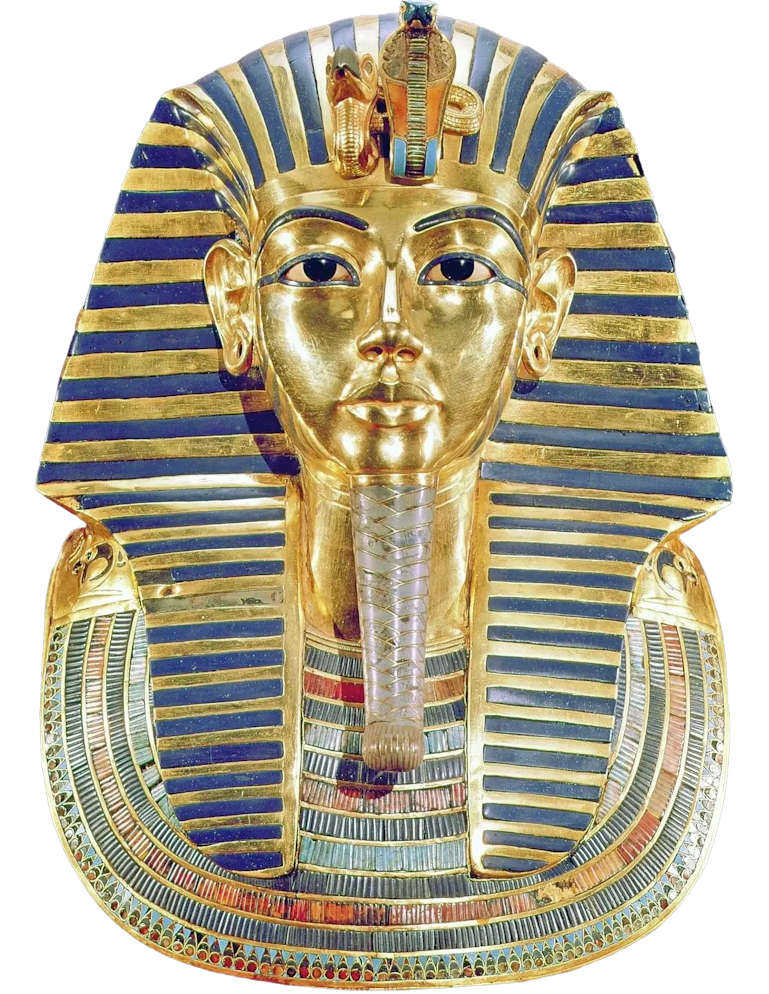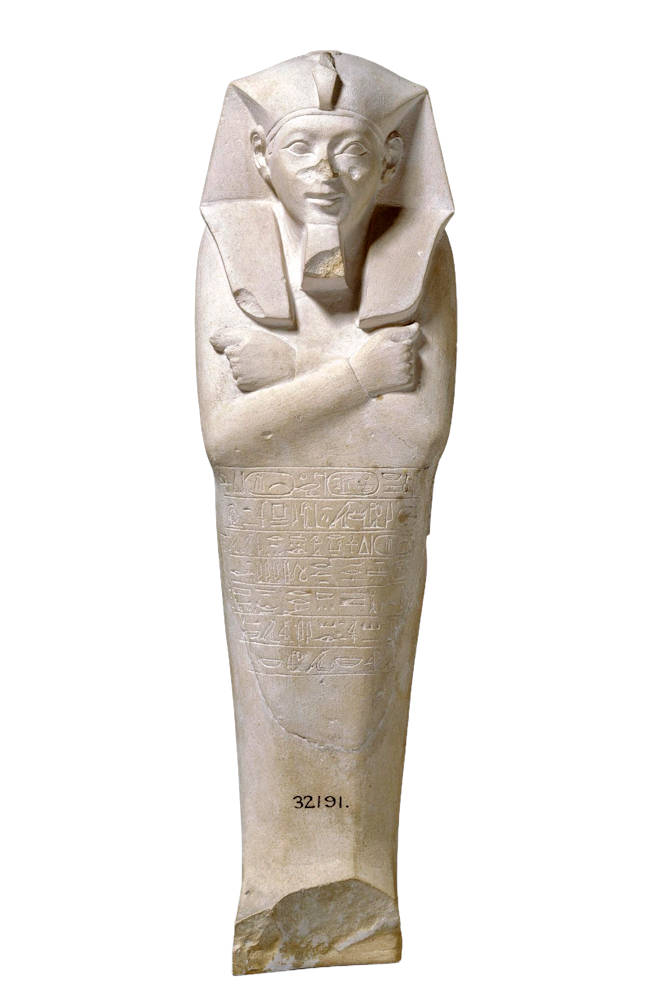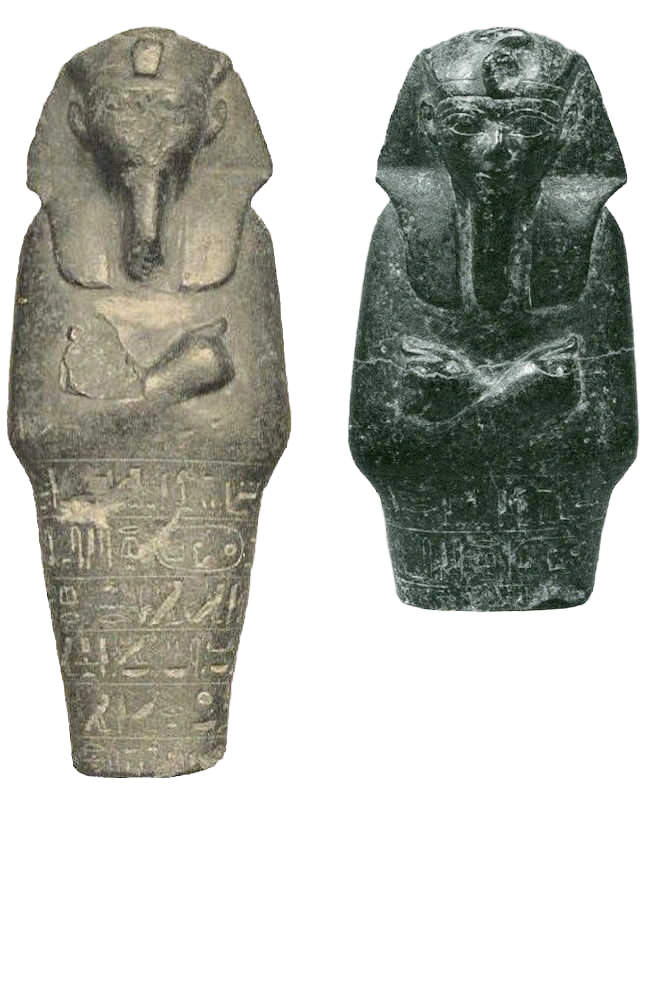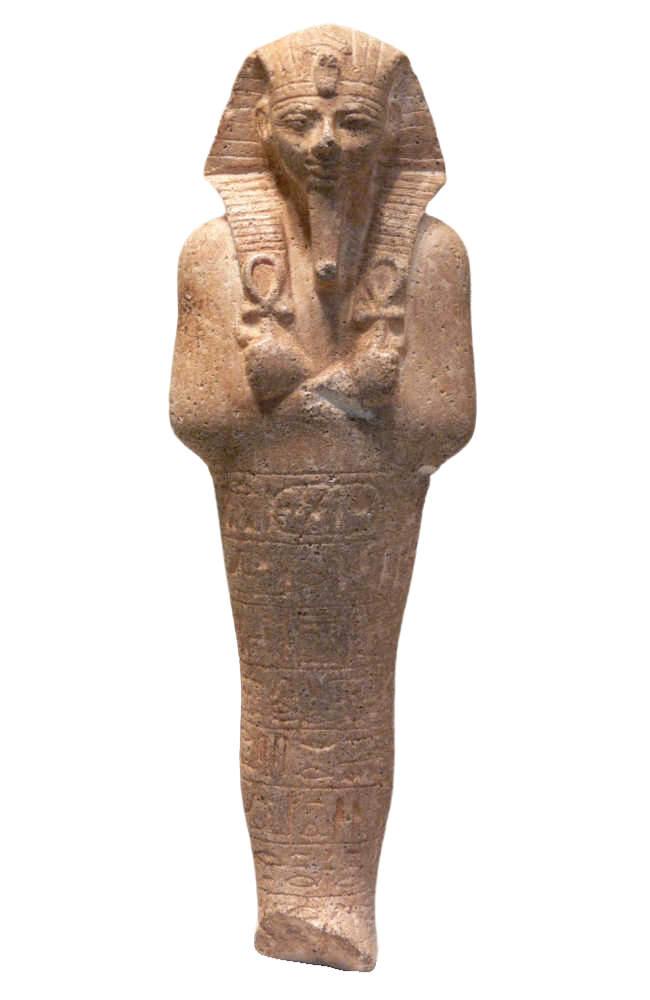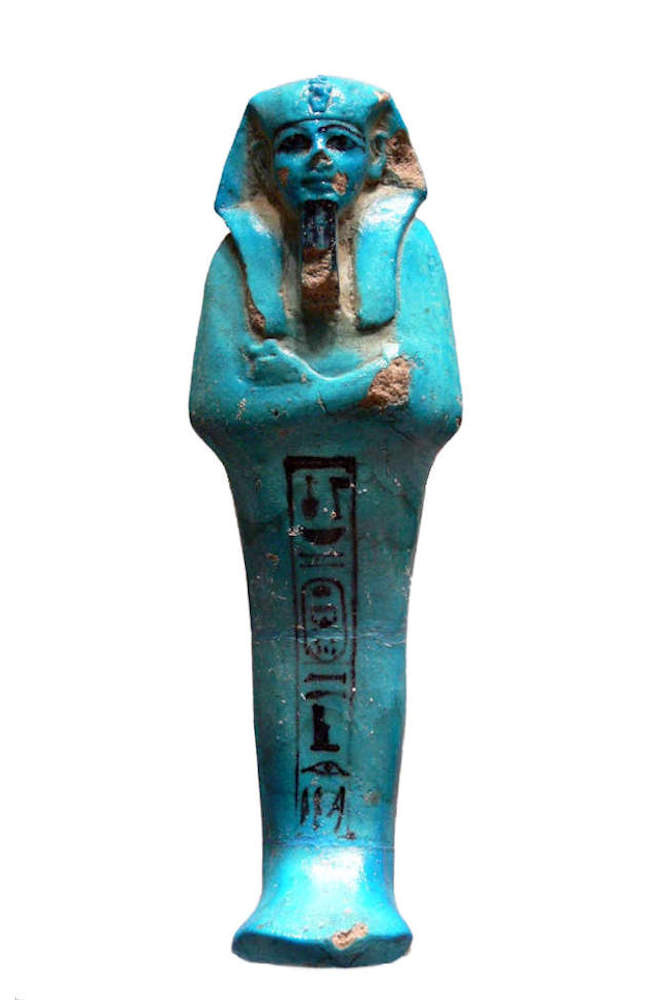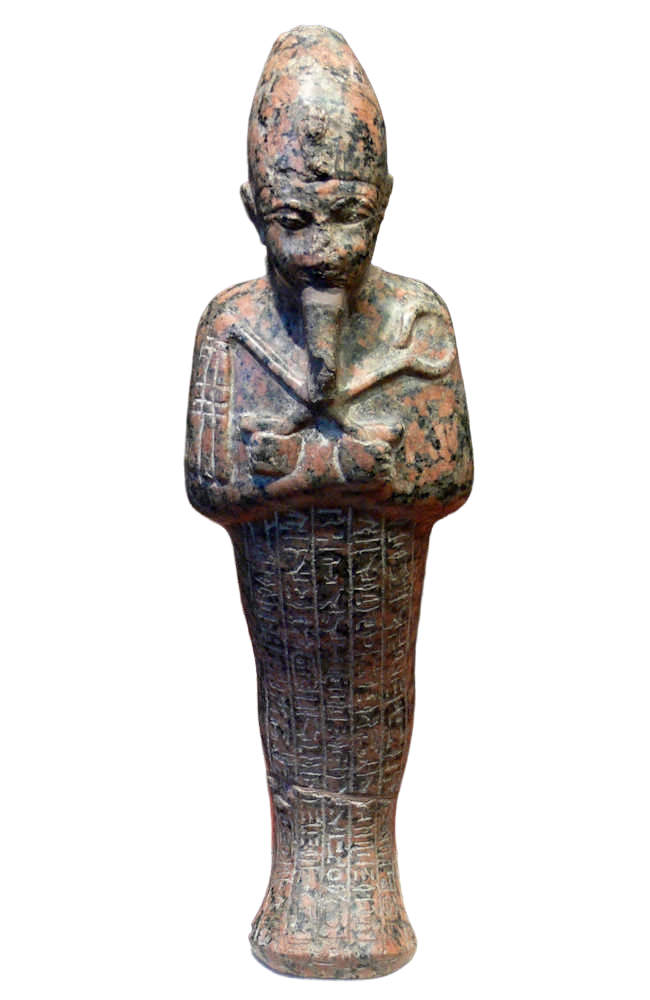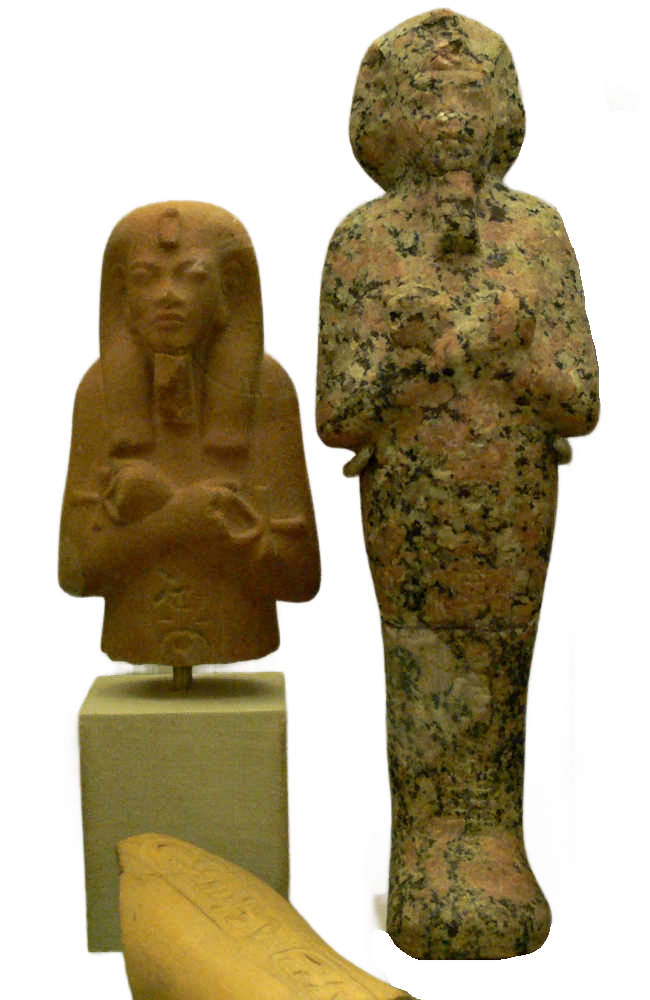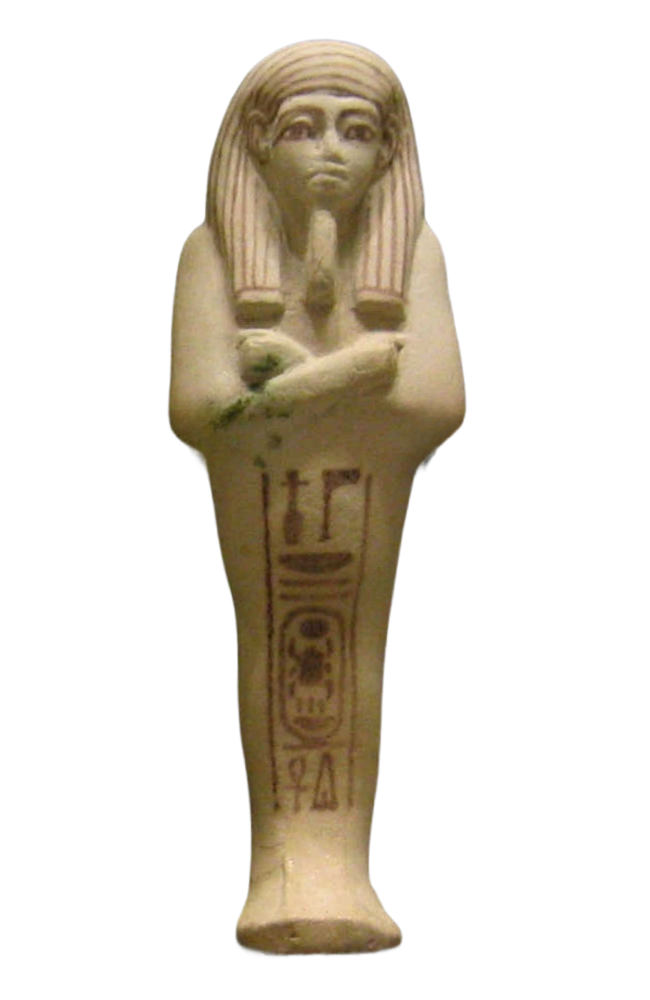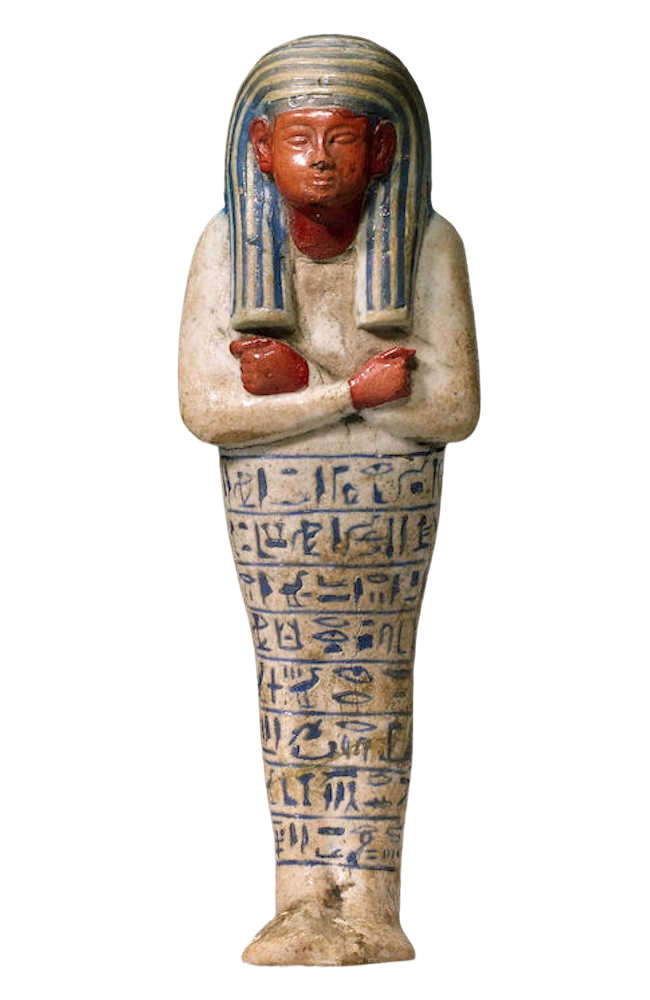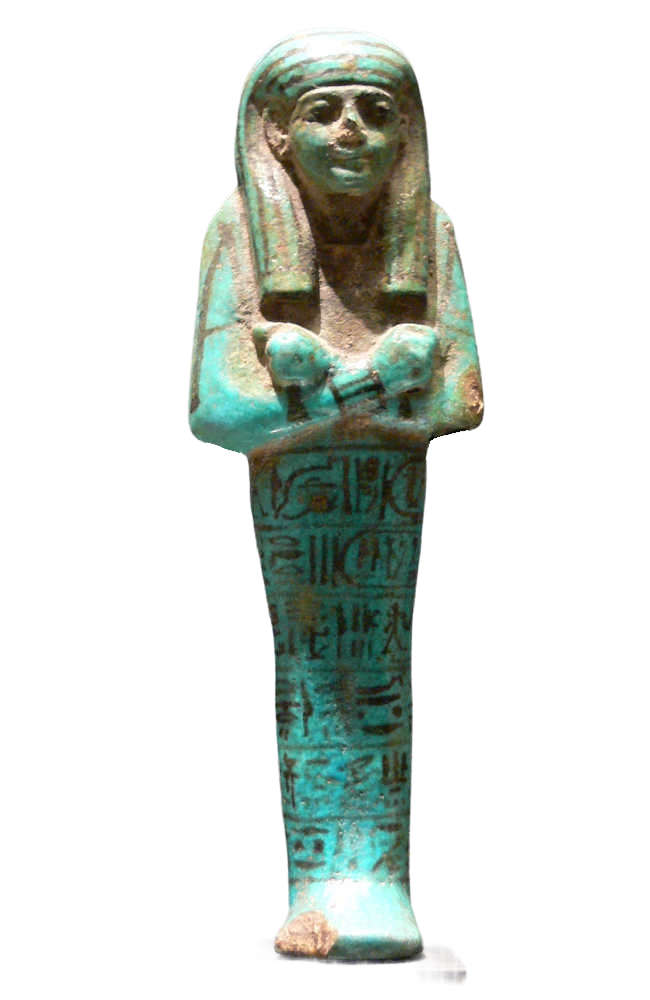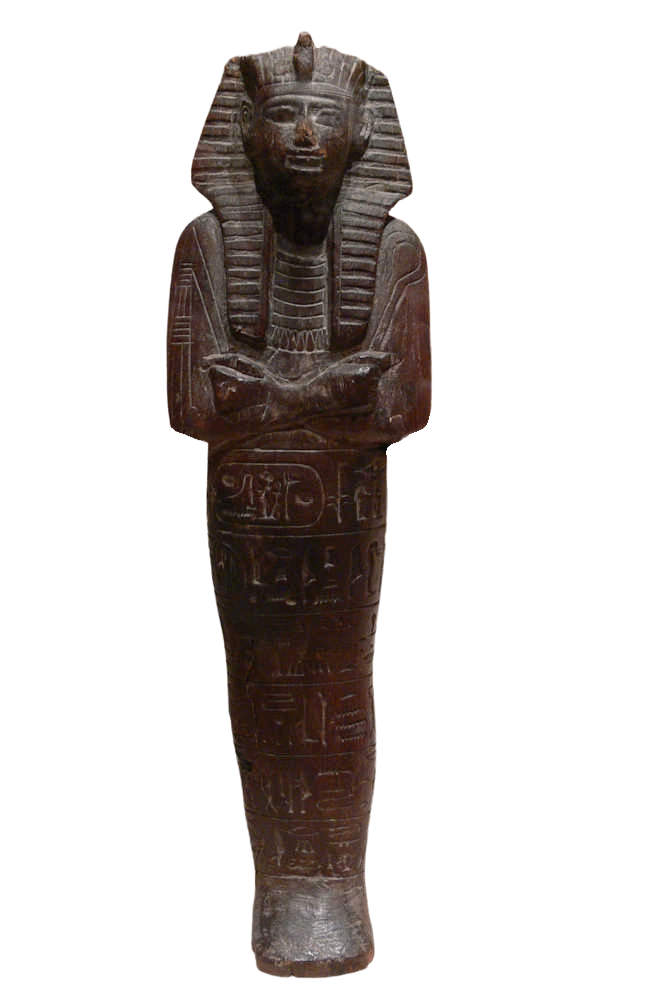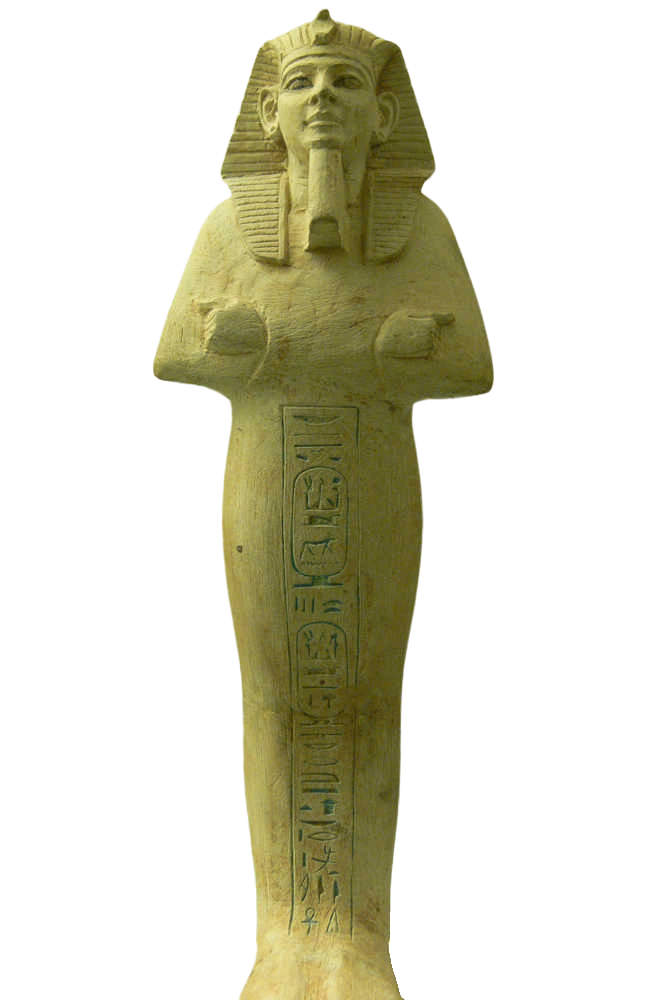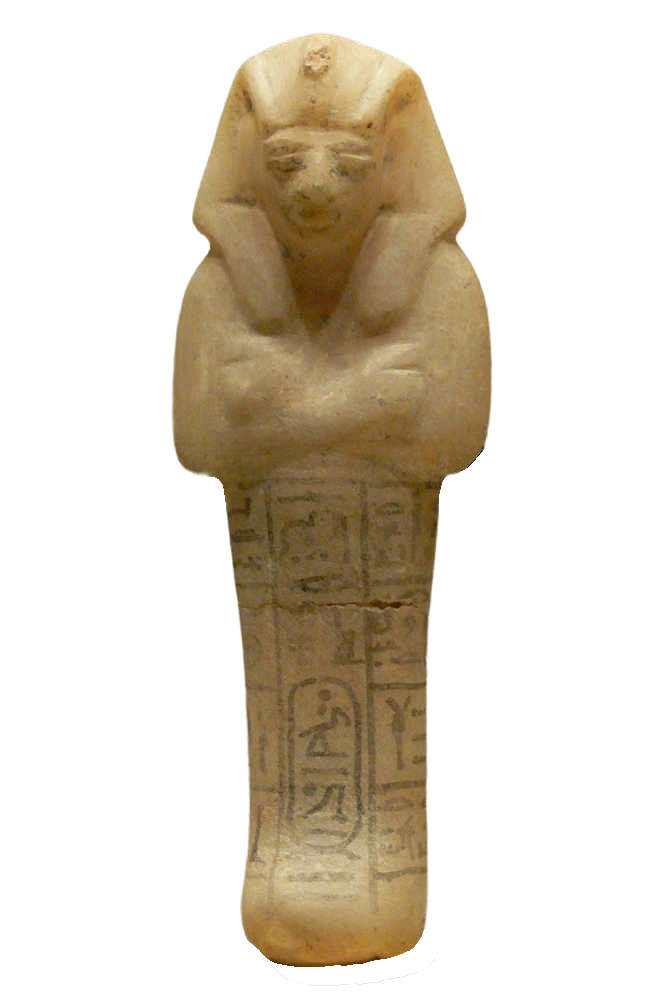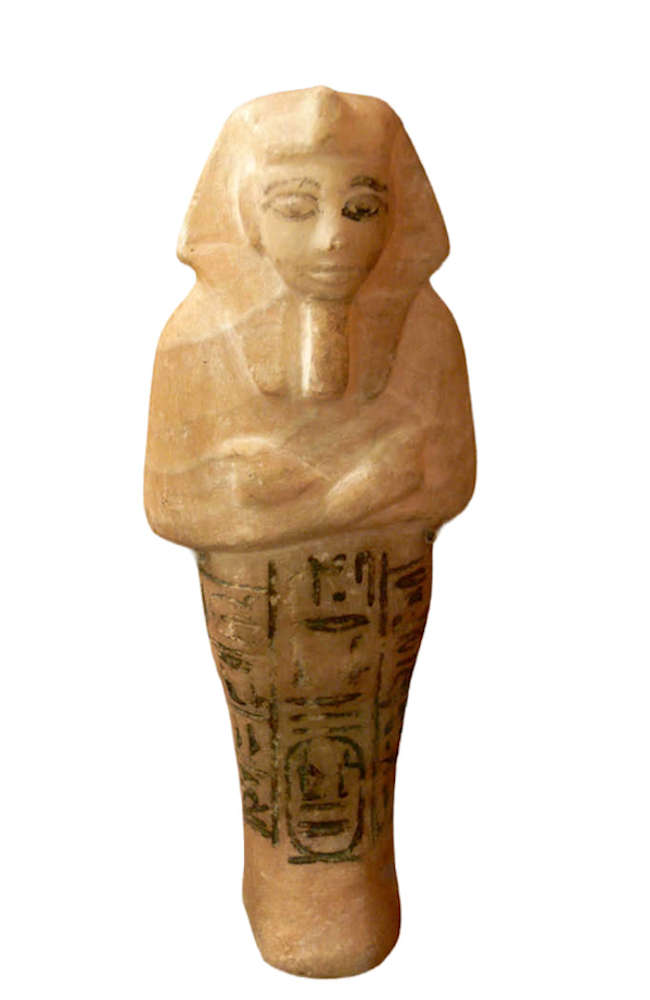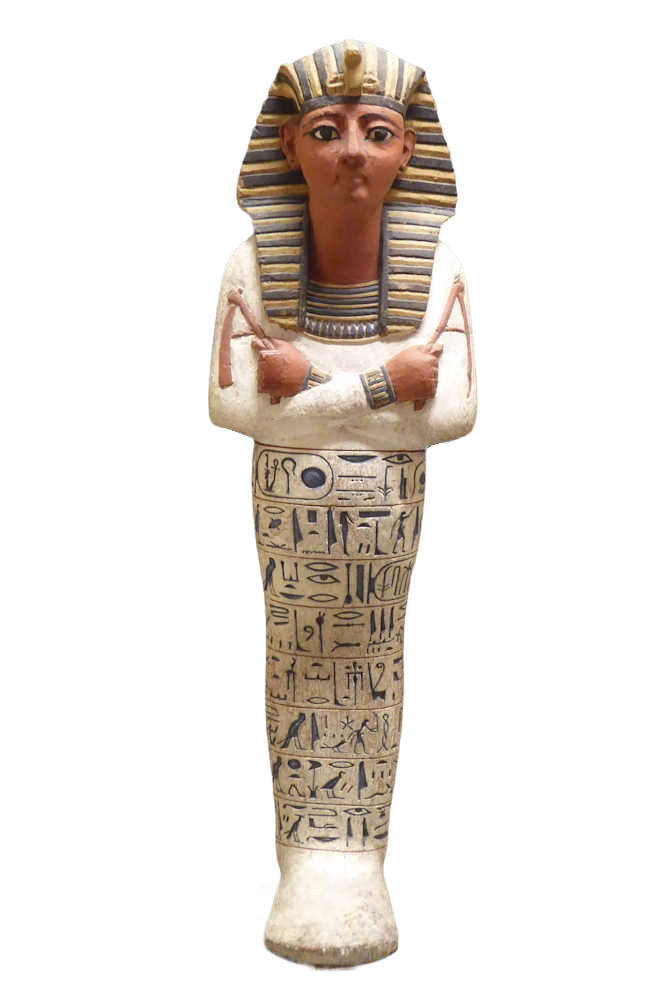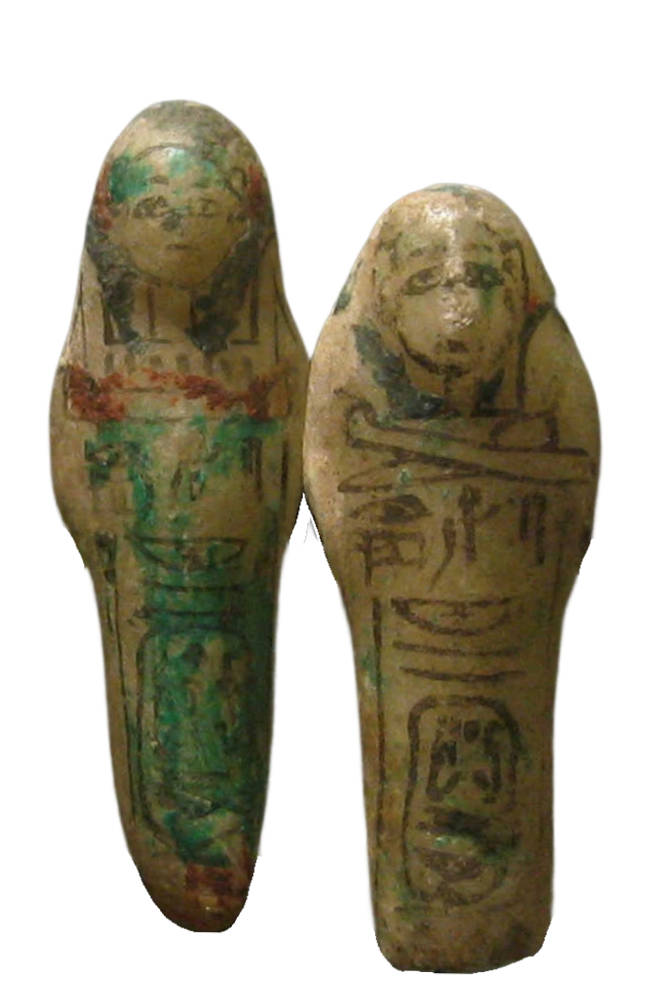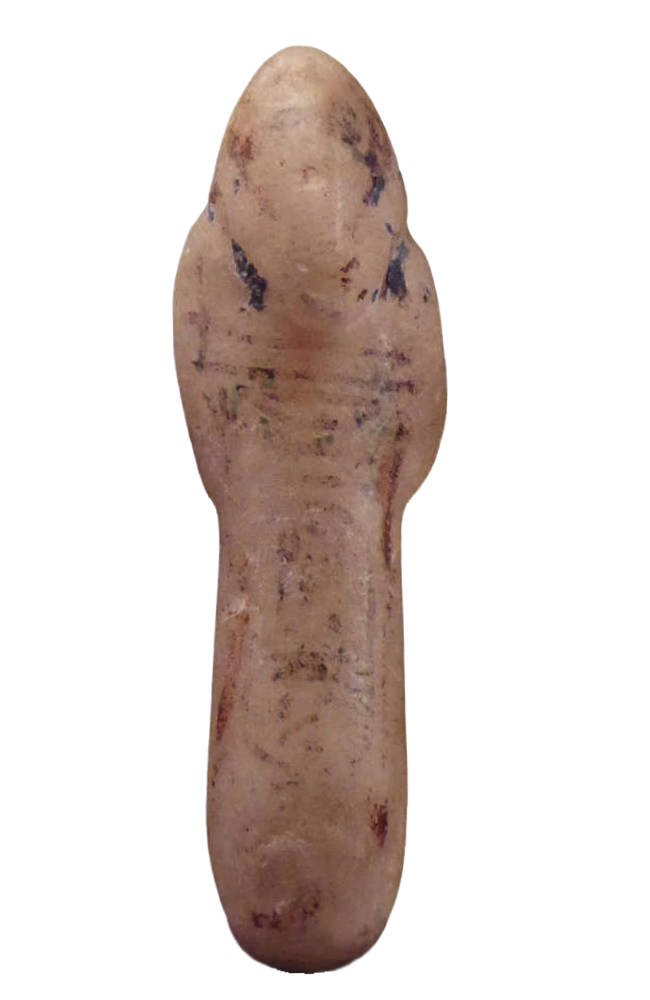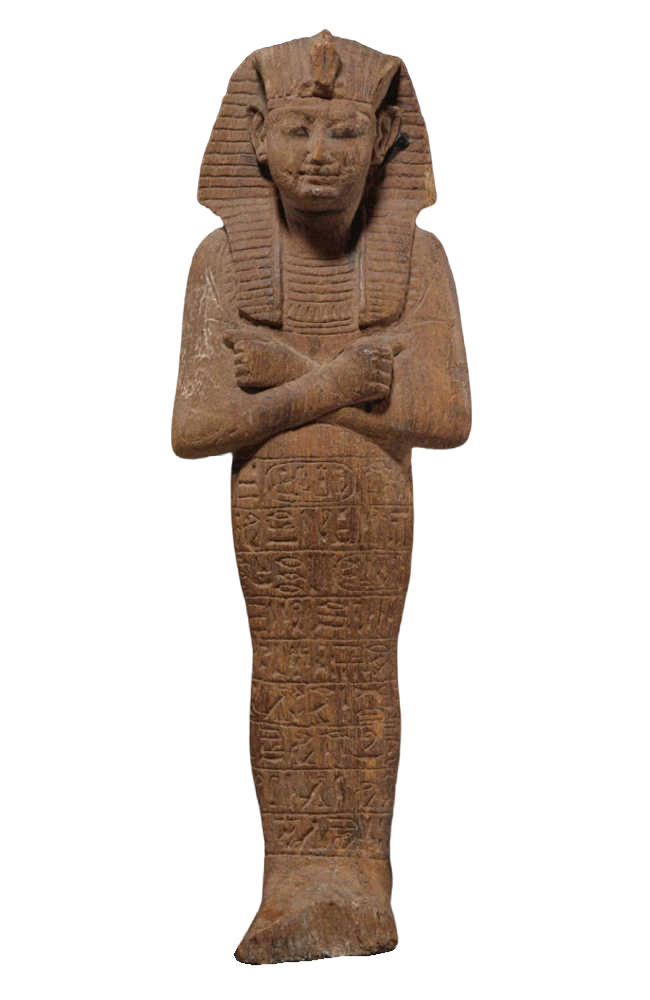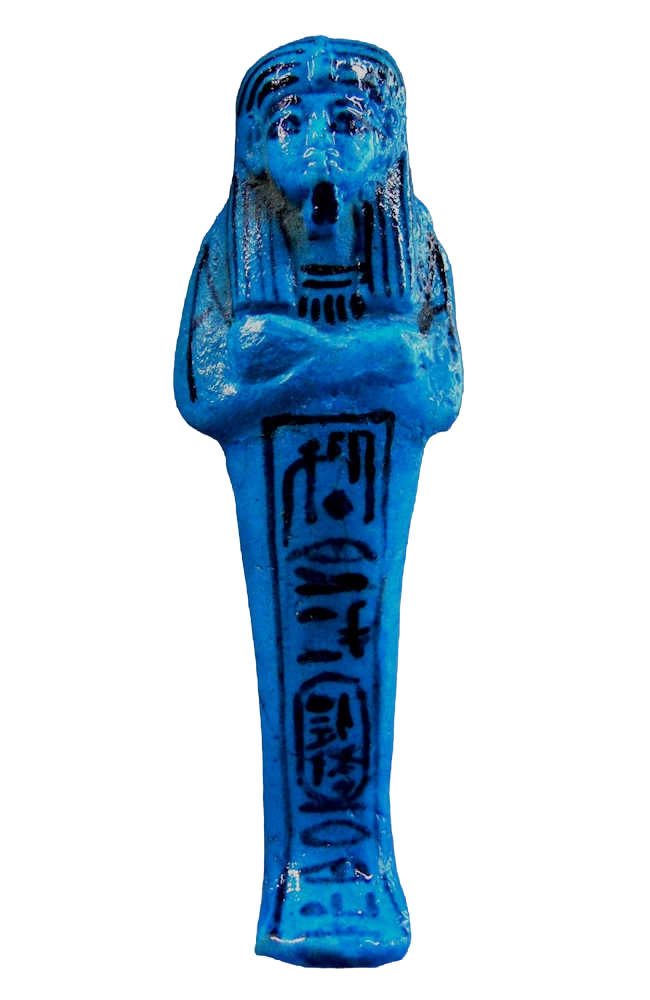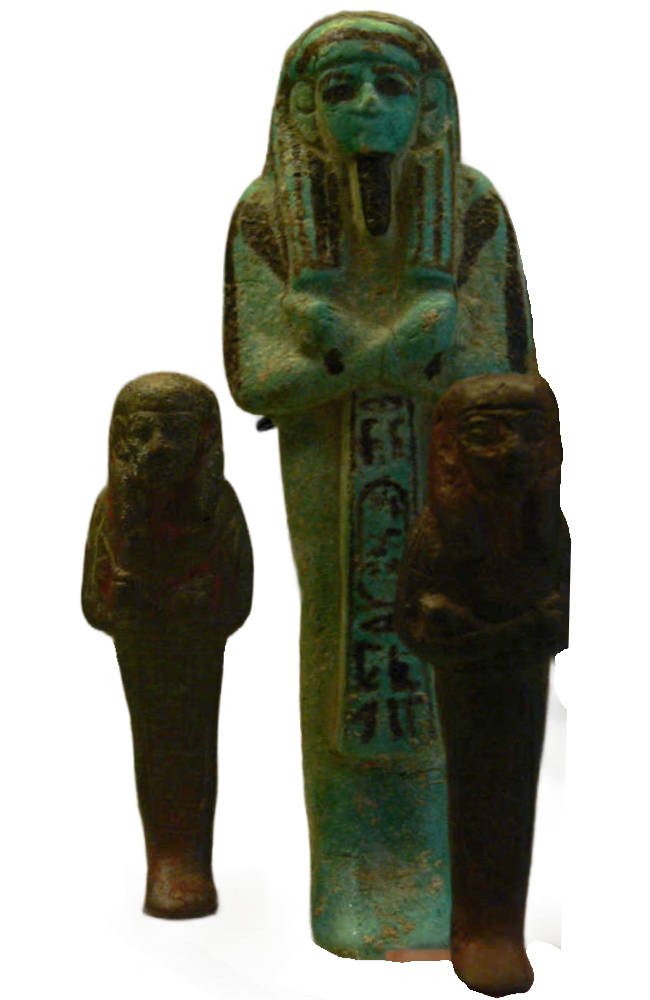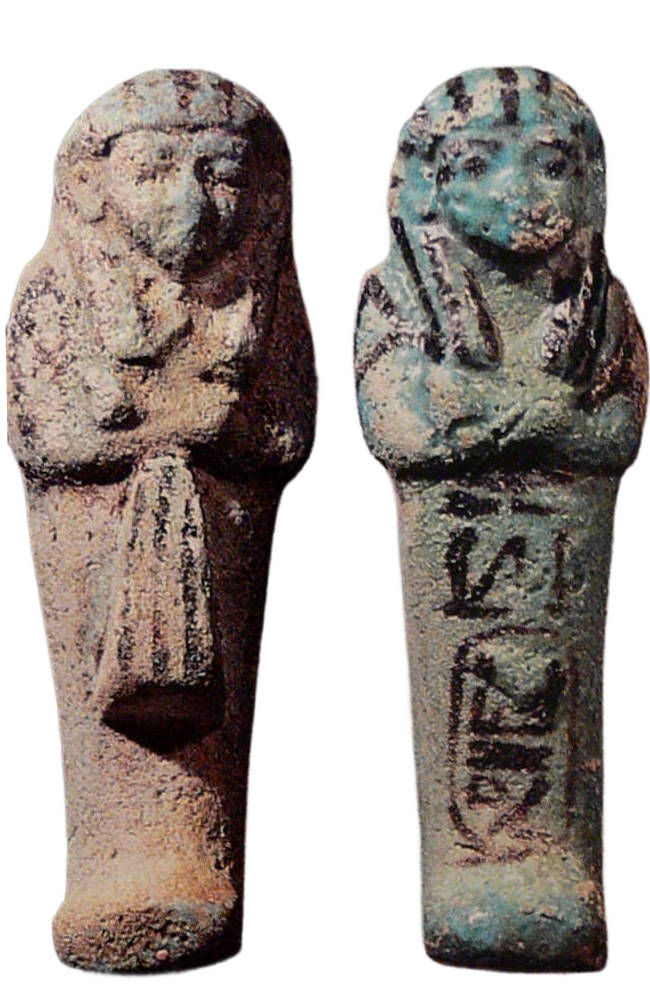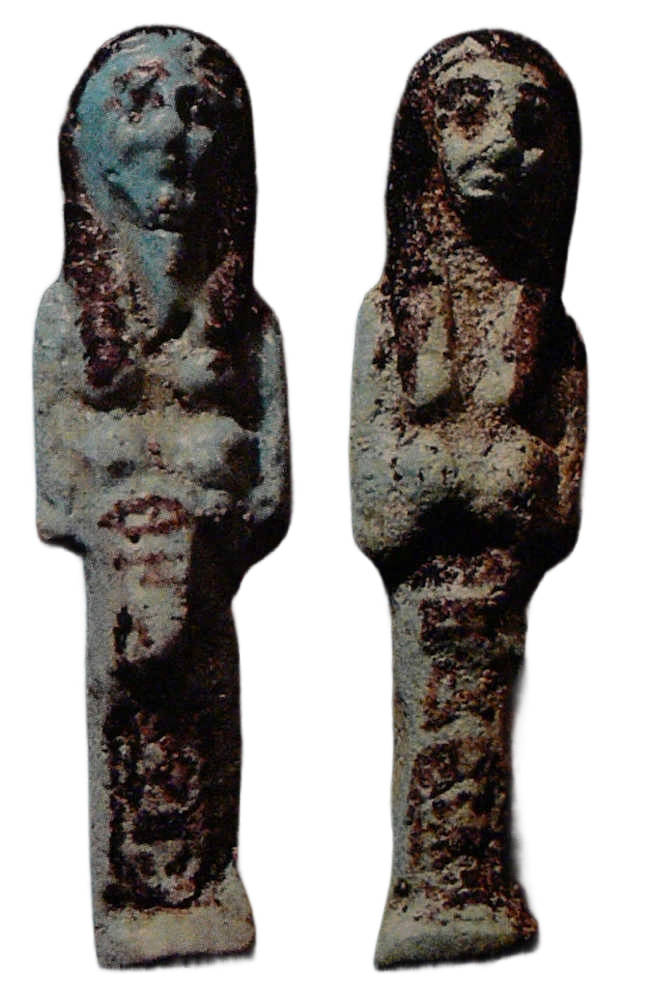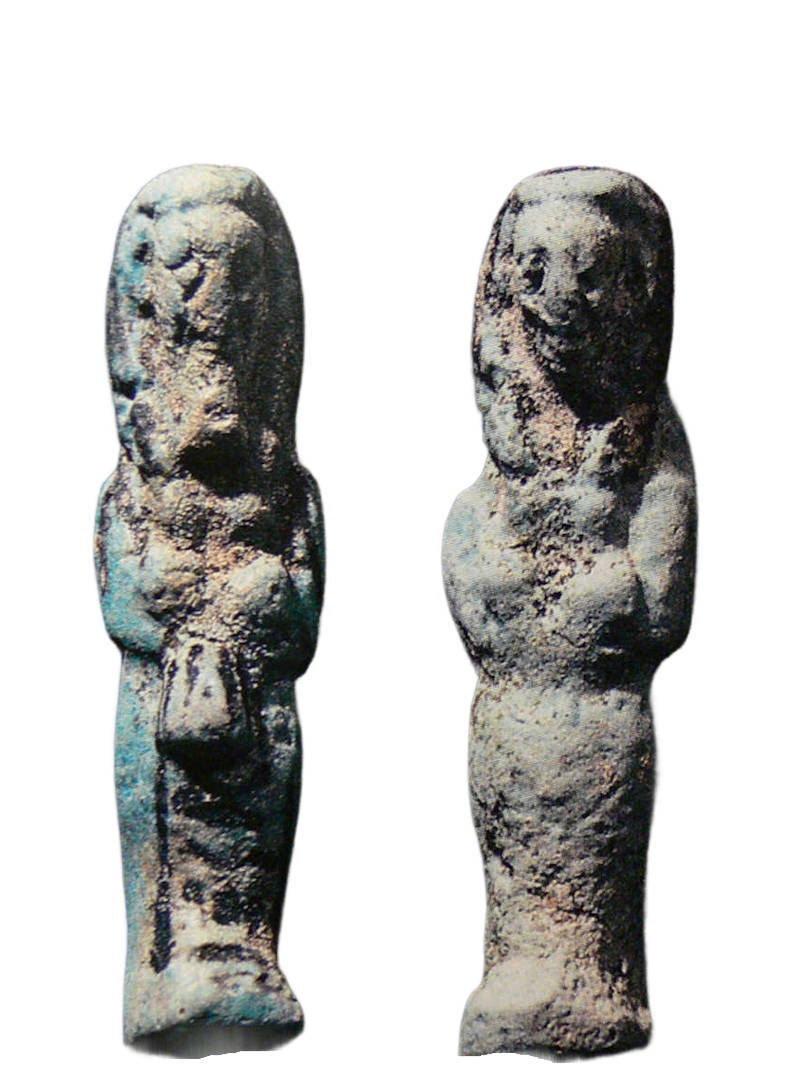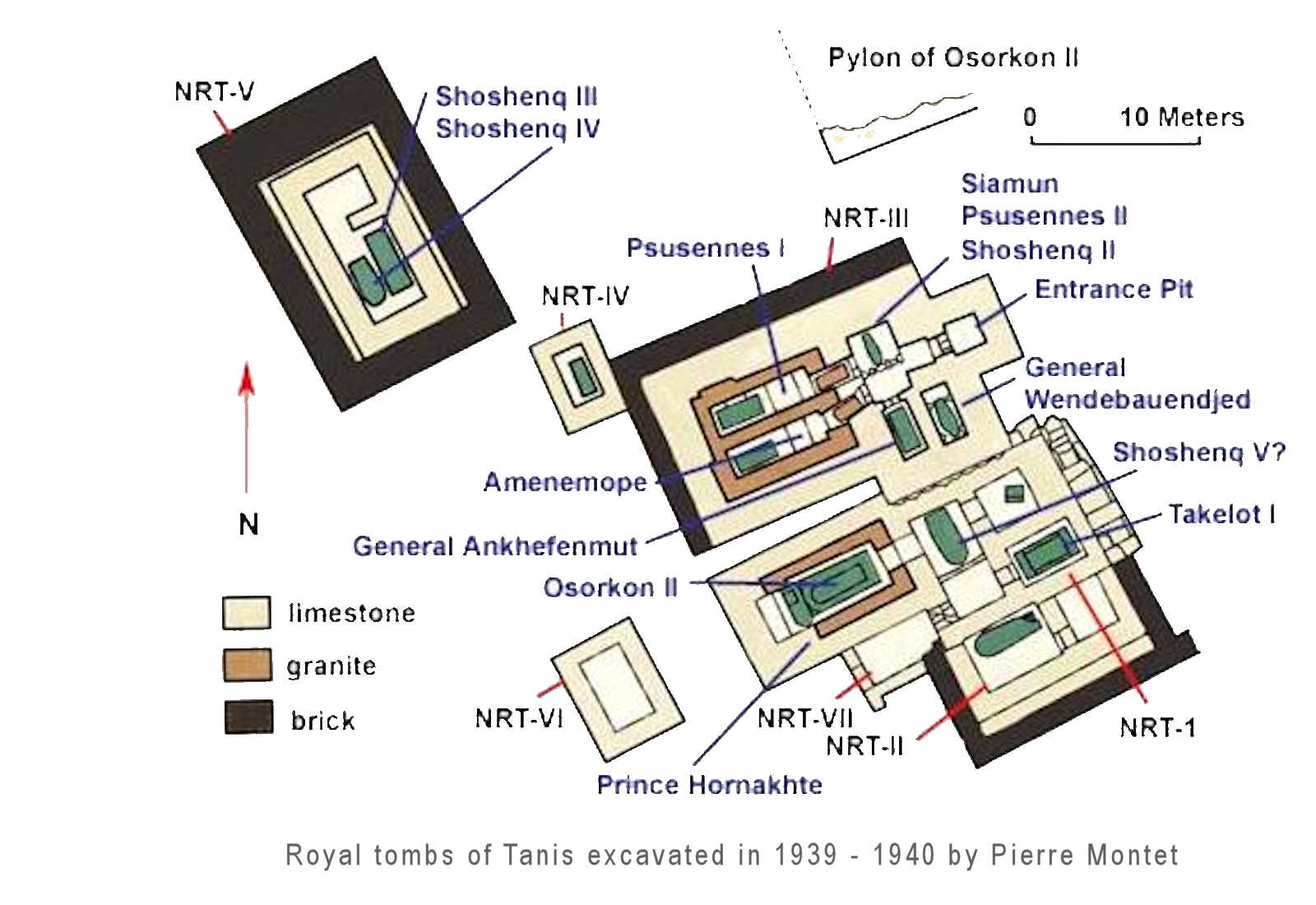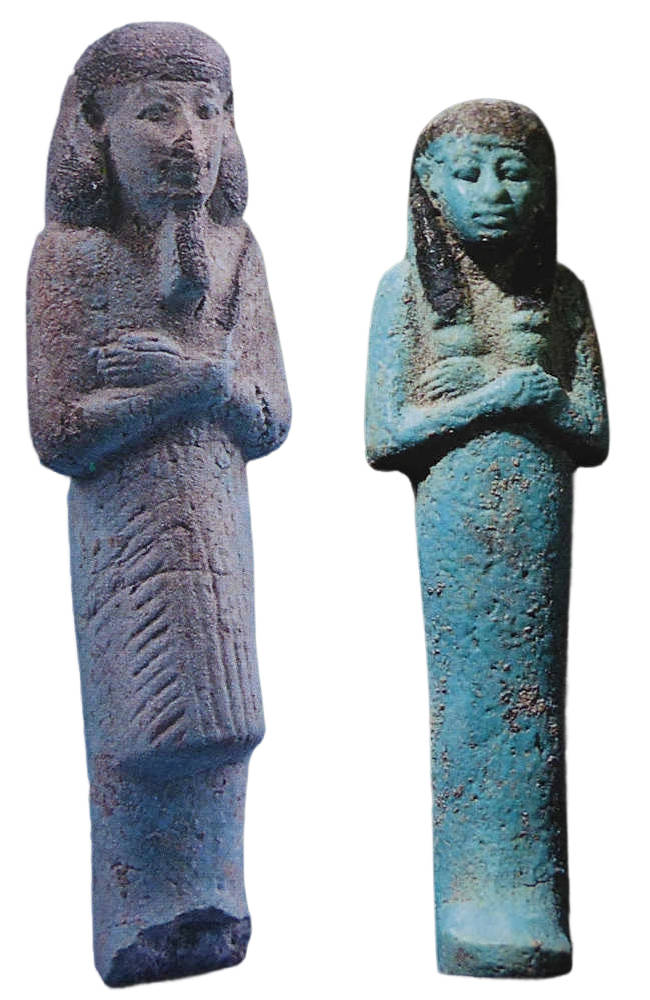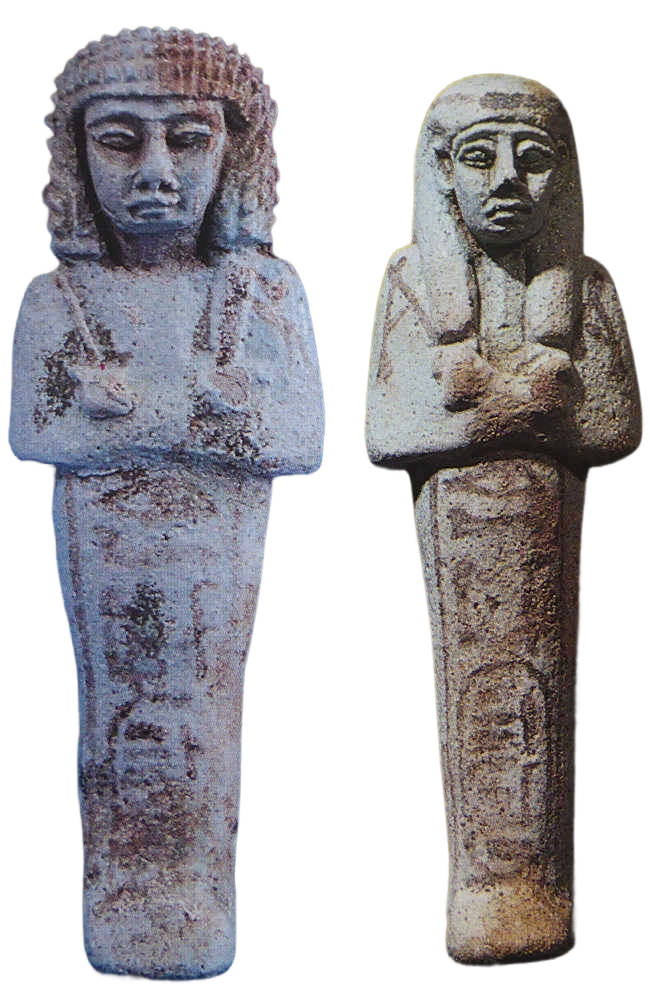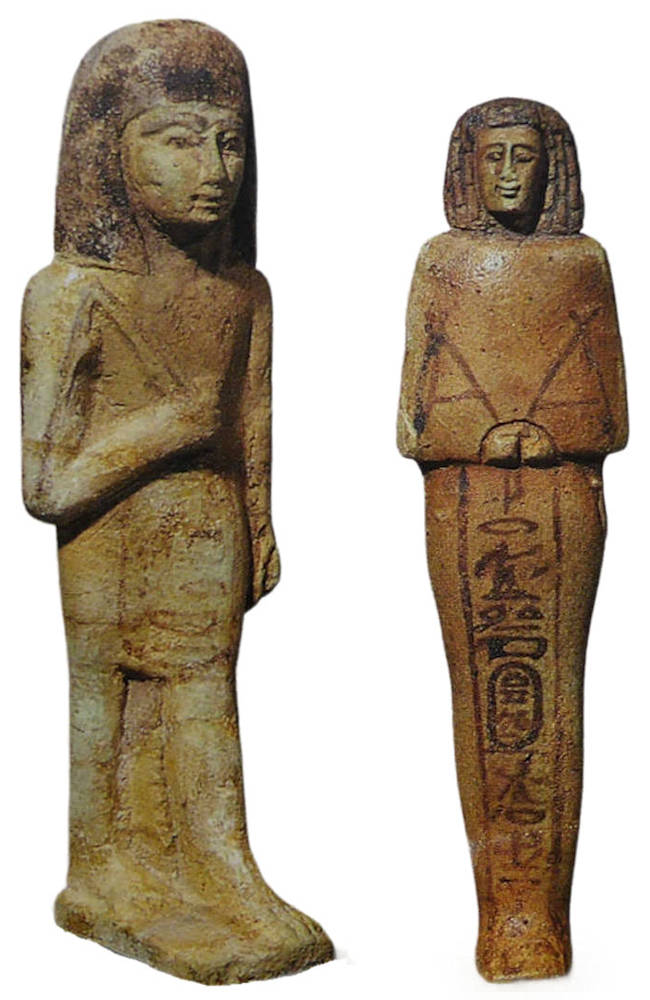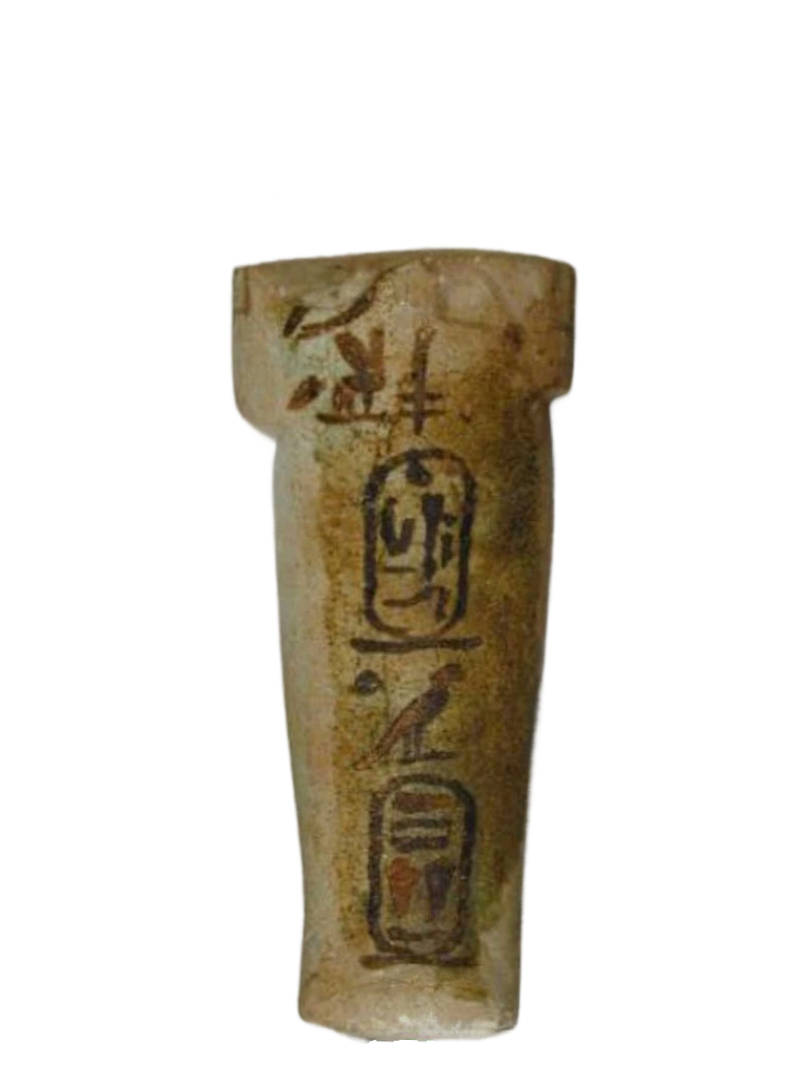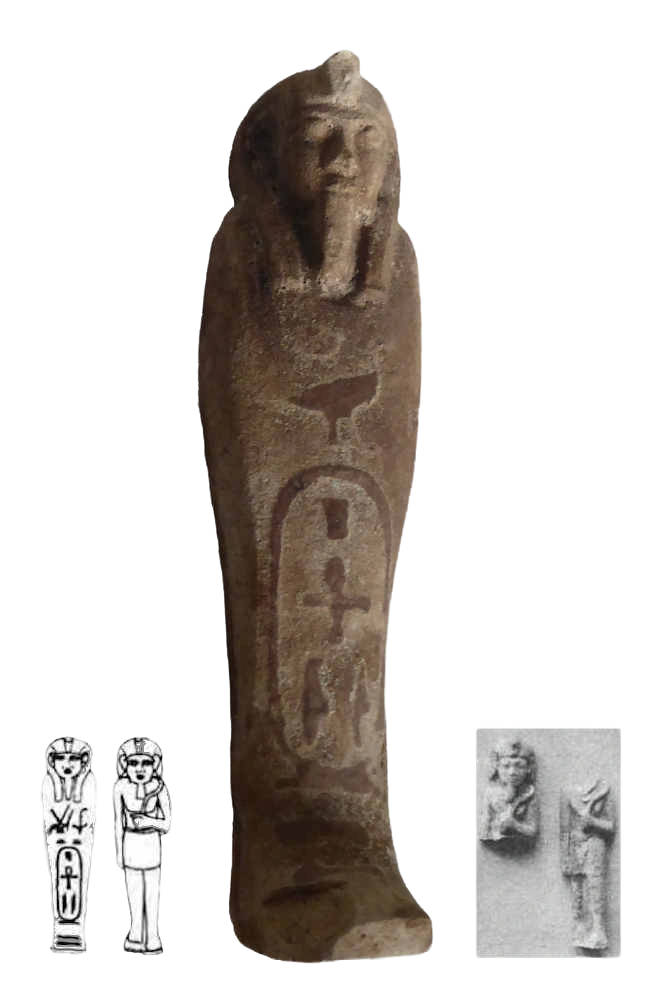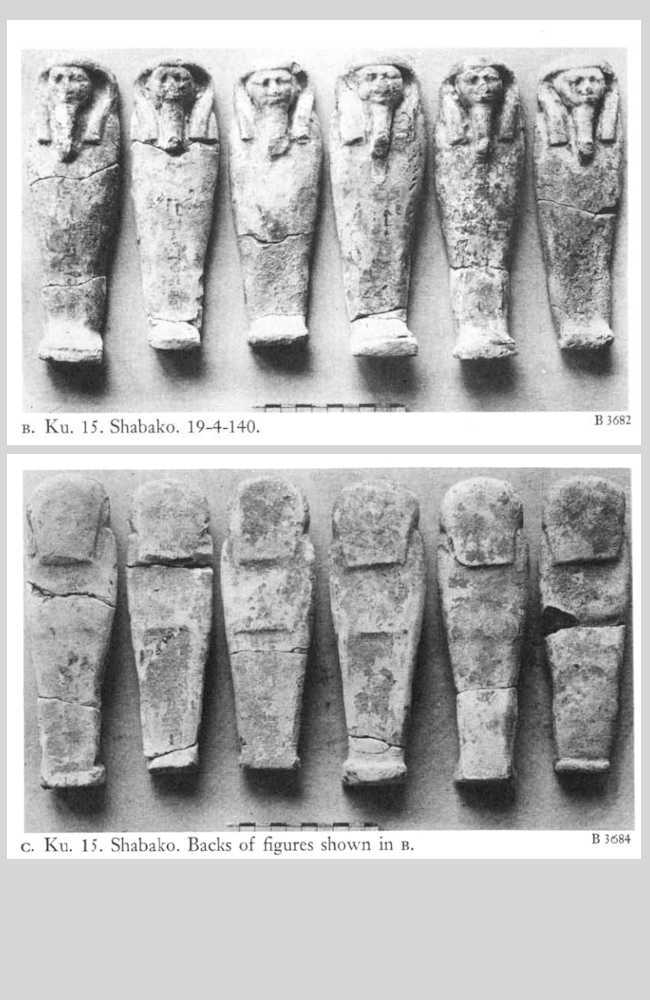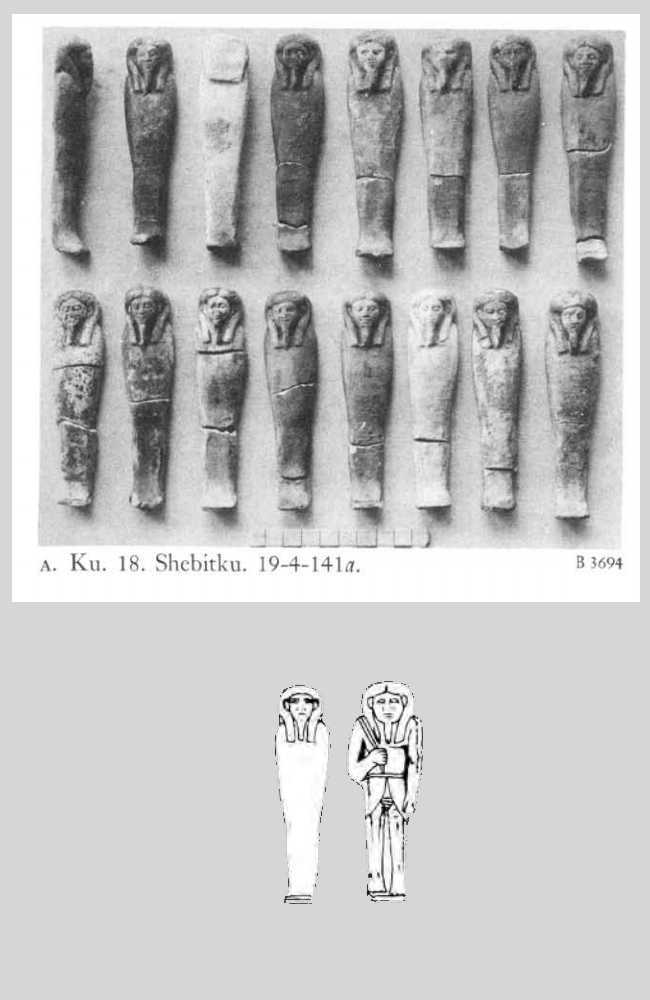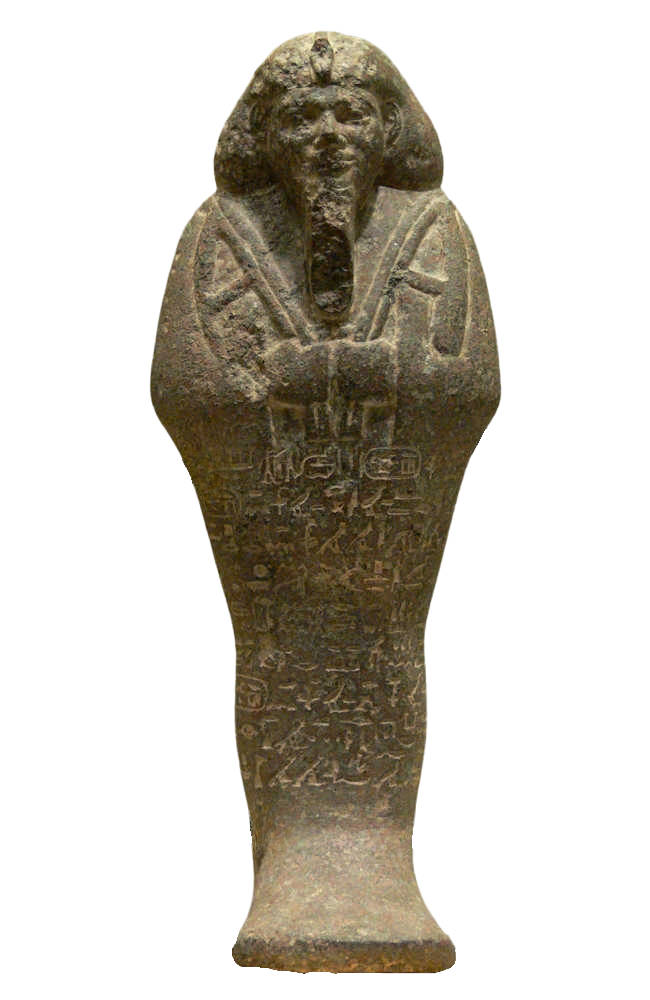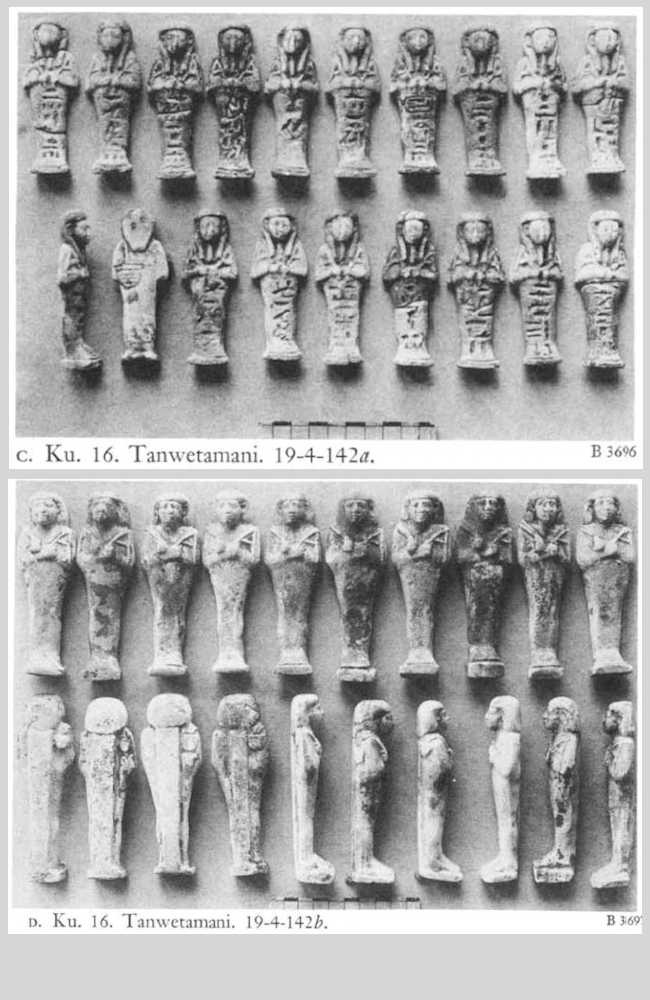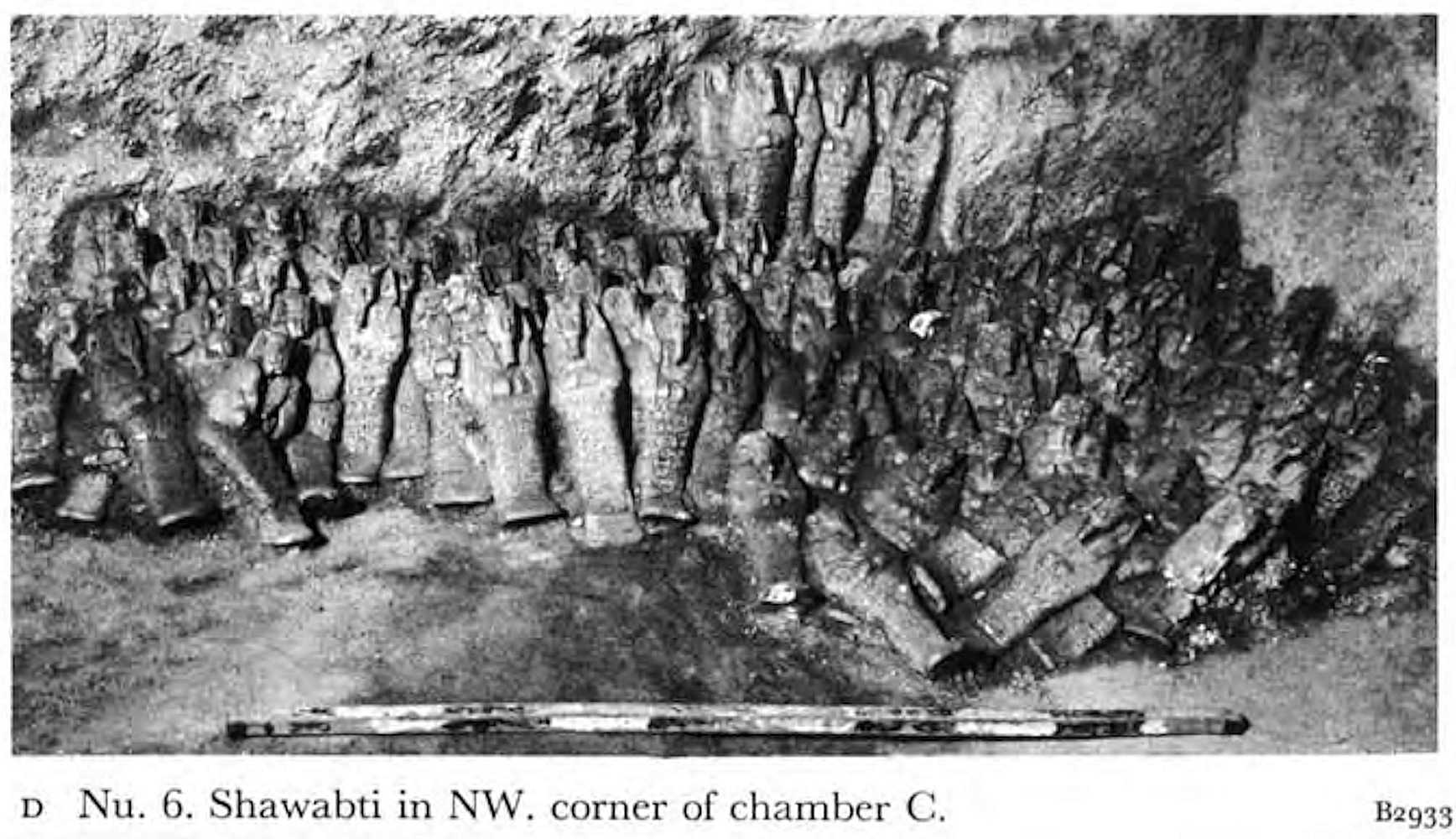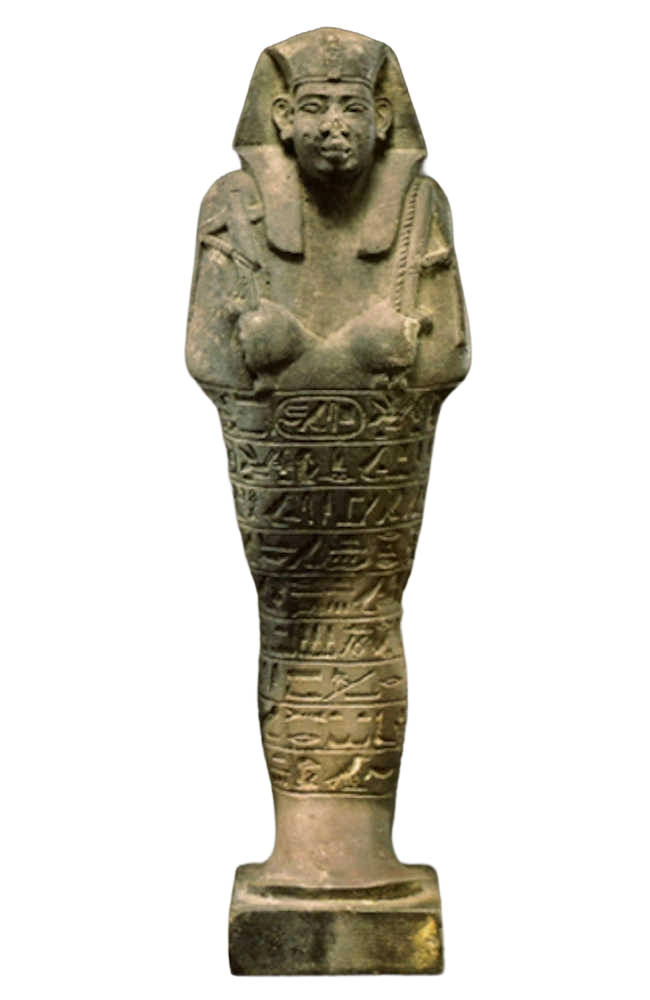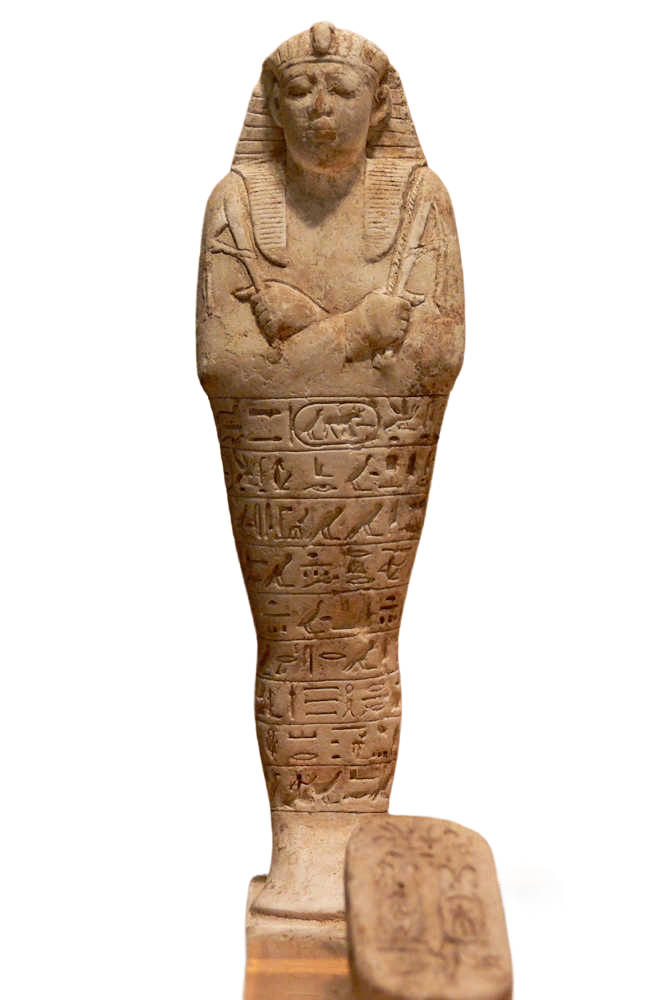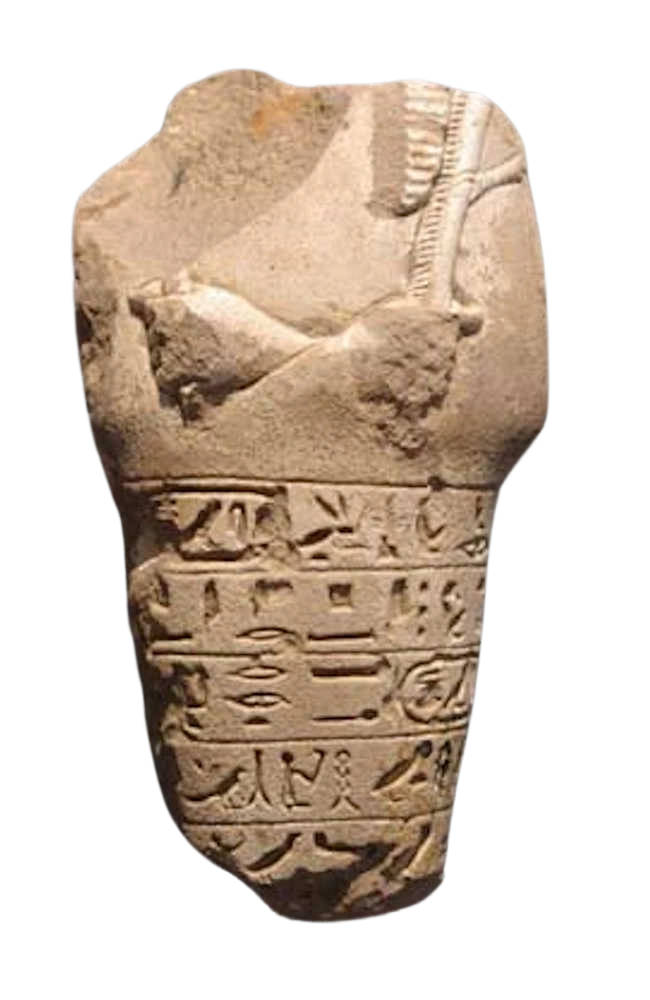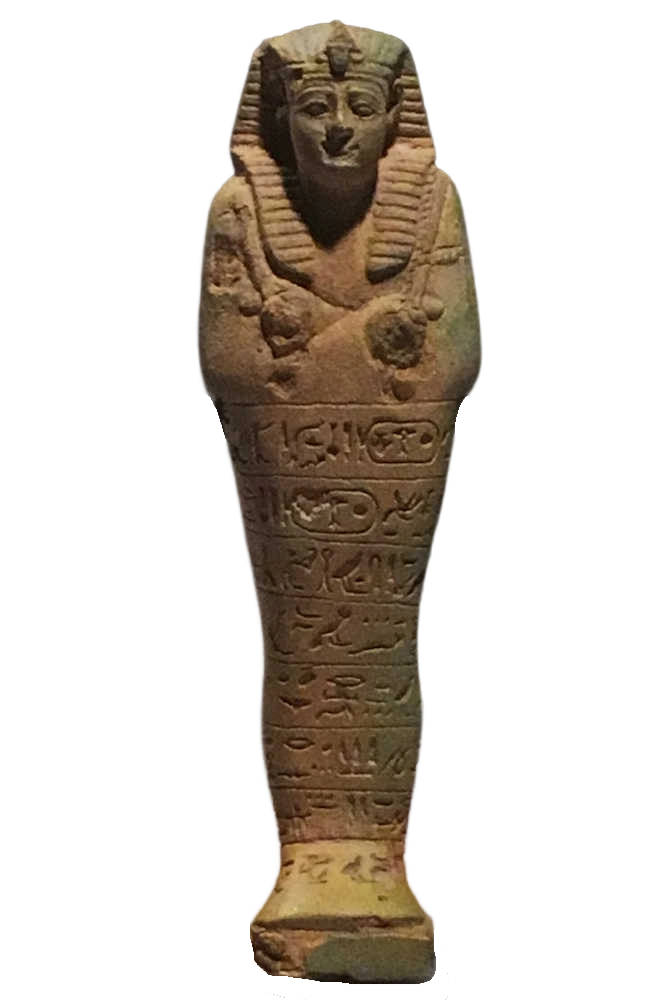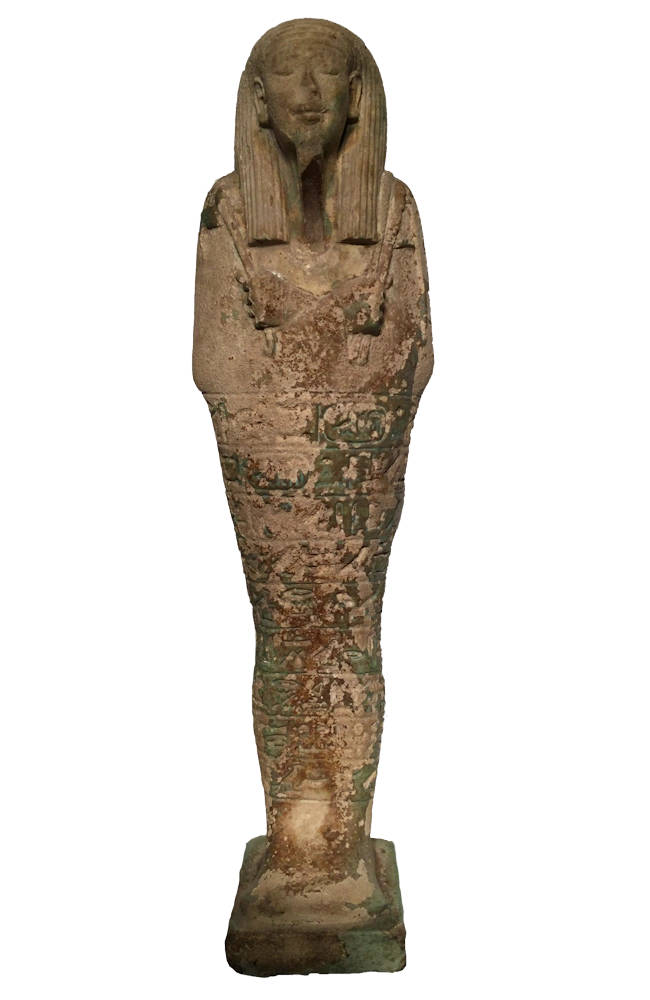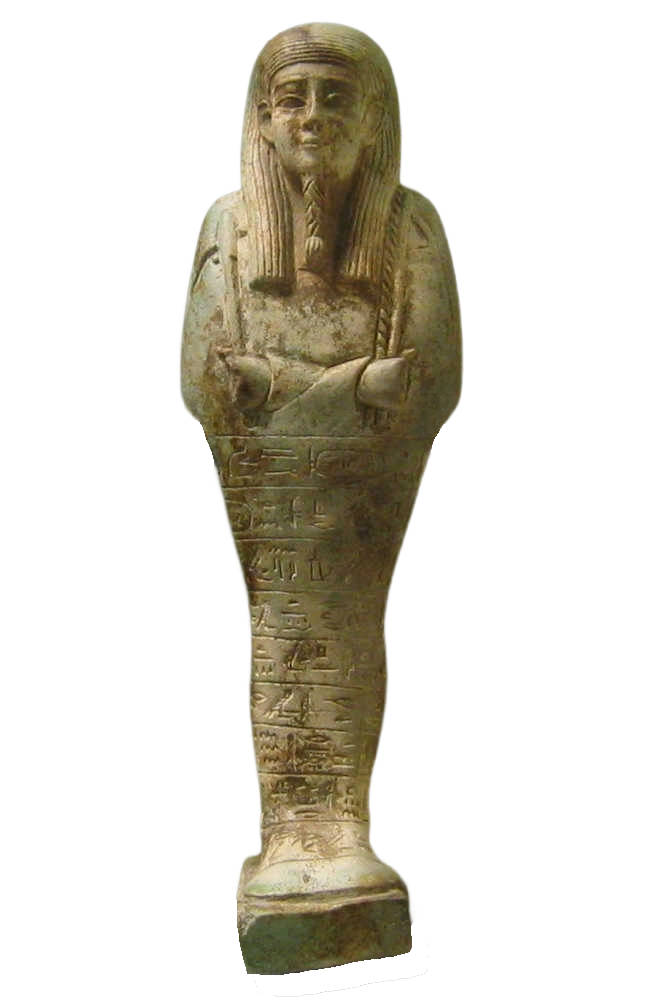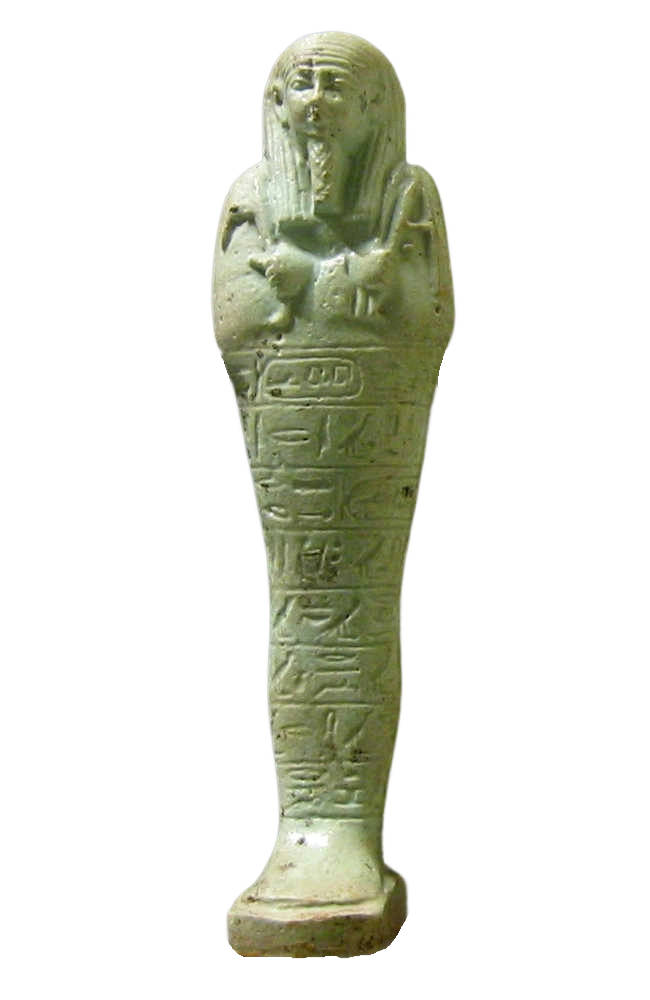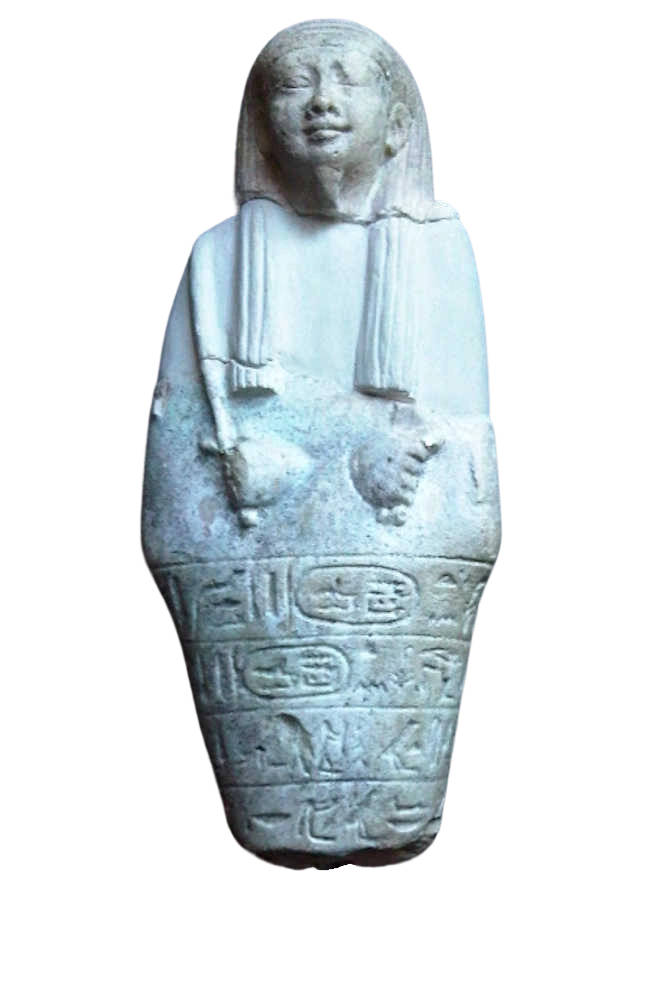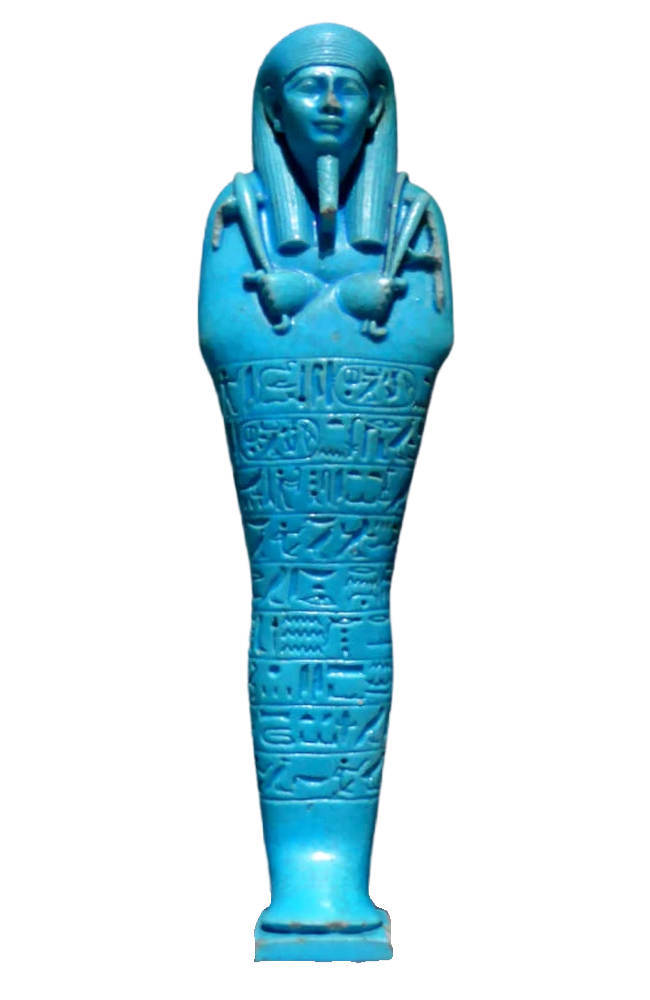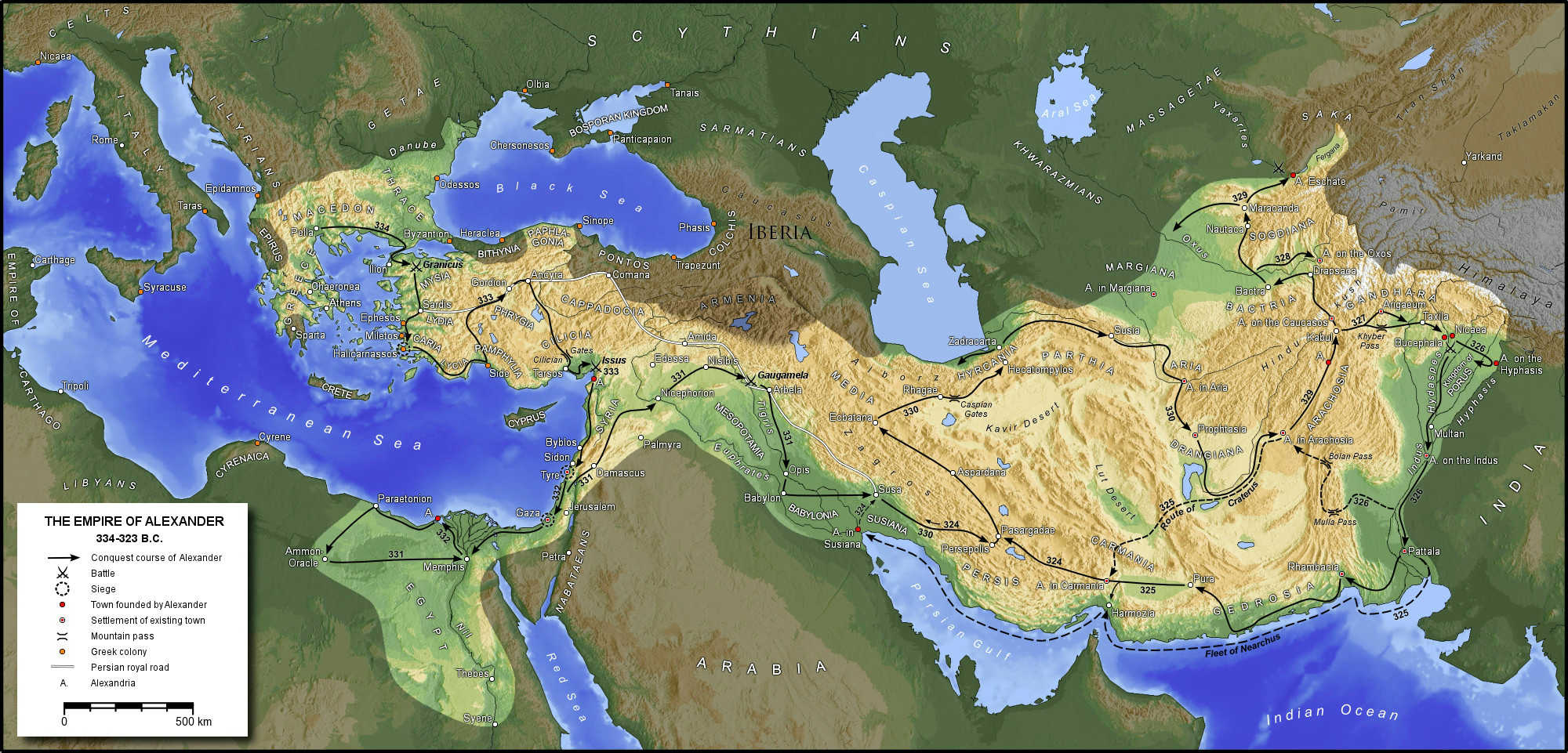Pharaoh shabtis
Ahmose I
Ahmose II
Alexander the Great
Amenemnisu (Neferkare)
Amenemope
Amenhotep I
Amenhotep II
Amenhotep III
Amenhotep IV (Akhenaten)
Amenmesse
Amyrtaeus
Apriës (Wahibra)
Arses (Artaxerxes IV)
Artaxerxes I
Artaxerxes II
Artaxerxes III
Ay
Bakenrenef
Cambyses
Darius I
Darius II
Darius III
Hakor (Achoris)
Harsiesis
Hatshepsut
Horemheb
Iuput I
Menkheppere
Merenptah
Necho II
Nectanebo I
Nectanebo II
Nepherites I
Nepherites II
Nimlot of Hermopolis
Osochor (Osorkon the elder)
Osorkon I
Osorkon II
Osorkon III
Osorkon IV
Pami
Pedubast I
Peftjauawybast of Heracleopolis
Pinedjem I
Piye (Piankhi)
Psammuthes
Psamtek I
Psamtek II
Psamtek III
Psusennes I (Pasebakhenniut I)
Psusennes II (Pasebakheniut II)
Ramses I
Ramses II
Ramses III
Ramses IV
Ramses V
Ramses VI
Ramses VII
Ramses VIII
Ramses IX
On this page you will find shabtis of pharaohs that have ruled over the Egyptian empire or a part of it (north or south). The first pharaoh known to have taken shabtis into his tomb was Ahmose I in 1546 BC. Although it is likely that all subsequent Egyptian pharaohs took shabtis with them, it is unfortunate that for many of them no shabtis have been found.
One of the reasons for this is the fact that pharaohs usurped their predecessors’ tombs or funerary gifts, or destroyed the contents of their tombs. Other reasons are that a number of tombs were plundered and vandalised in ancient times, and exposure to the elements has also taken its toll. During the 21st Dynasty the high priests removed many pharaohs from their tombs and reburied them in secret locations. They did not move the shabtis to the new tombs, and many of them have disappeared. In some cases small fragments have been recovered.
In all probability this overview is incomplete. I expect that shabtis from old collections or new excavations will turn up over the coming years. If so, they will be added to the overview.
A great many pharaohs own shabtis of different types. Seti I, for example, has several faience, wooden and glazed soapstone shabtis, whose dimensions may also vary considerably. In order to keep the overview well-organised I have opted to include only one photo for each pharaoh.
The ushabtis of the kings of Kush (Nubia) are only included if they have ruled Egypt. The pharaohs of the 27th and 31st Dynasties came from Persia (Iran) and have been buried there without ushabtis. The overview ends with the 31st Dynasty in 332 BC, when Alexander the Great conquered Egypt.

The King List of Abydos, also known as the Abydos Table, is a list of the names of 76 kings of ancient Egypt found on a wall of the temple of Seti I in Abydos, Egypt. It consists of two rows of cartouches (76 in total) dating from the 1st dynasty to Seti I in the 19th dynasty. Full screen
Photos panoramaview: VB 2021
Detailed information on the king’s list at this Dutch site
18th Dynasty
1570 – 1293 BC, New Kingdom
Ahmose I
18th Dynasty, 1570 – 1546 BC
Stone, 28 cm
Provenance unknown
The location of the original tomb is not known. His body was among the royal mummies discovered in the Royal Cache DB320
British Museum, London
EA 32191
Photo: British Museum
Amenhotep I
18th Dynasty, 1551 – 1524 BC
No shabti known
The location of the original tomb is not known. His body was among the royal mummies discovered in the Royal Cache DB320
Thutmose I
18th Dynasty, 1524 – 1518 BC
No shabti known
Tomb KV 20 was quarried as the original burial place for the King. Thutmose III moved his grandfather to a new resting place KV 38. The High Priests of the 21st dynasty moved his coffin(s) and maybe his mummy to the Royal Cache DB 320. Although a coffin had been remodelled for the burial of Pinedjem I, it held an 18th Dynasty mummy which has since been identified as Thutmose I. But there is doubt because the mummy has the arms extended, wheras a pharaoh should have his arms crossed at the breast.
Thutmose II
18th Dynasty, 1518 – 1504 BC
No shabti known
The location of the original tomb is not known. His body was among the royal mummies discovered in the Royal Cache DB320
Hatshepsut
18th Dynasty, 1498 – 1483 BC
Left basalt, 18.6 cm
Meermanno Museum,
The Hague 79/130
Right basalt, estimated 14 cm
Bordeaux, 9087
Probably excavated by Howard Carter in 1903 among the foundation deposits of KV 20
Photo: compilation VB from unknown publications
Thutmose III
18th Dynasty, 1504 – 1450 BC
No shabti known
The King was interred in KV 34. The tomb was plundered in antiquity and its location was lost. It was rediscovered and first excavated in 1898 under Victor Loret. The pharaoh’s body was among the royal mummies discovered in the Royal Cache
One shabti was previously attributed to this king, see here
Amenhotep II
18th Dynasty, 1453 – 1419 BC
Limestone, 20.5 cm
In 1898 Victor Loret discovered Amenhotep’s tomb (Royal Cache KV 35). The mummy of Amenhotep II was still there. Together with Tutankhamon these are the only royal mummies in the King’s Valley found in their own tomb. The tomb was also used as a cache for other royal mummies that were reburied there by the 21st Dynasty High Priests.
The Metropolitan Museum of Art, New York 66.99.158
Photo: VB
Amenhotep III
18th Dynasty, 1386 – 1349 BC
Pink granite, 58 cm
The three pieces of this shabti were probably excavated in KV 22 in the West Valley, head and body has been separated for 170 years. His mummy was found in 1898 by Victor Loret in Amenhotep II’s tomb KV 35
Louvre, Paris E27488 (head),
N467 (body)
Photo: VB
Amenhotep IV (Akhenaten)
18th Dynasty, 1350 – 1334 BC
Various stone
Probably found in El-Amarna
The Metropolitan Museum of Art, New York
Photo: VB
Smenkhkara
18th Dynasty, 1336 – 1334 BC
No shabti known
His/her body may have been found in KV 55 by Edward Ayrton in 1907. This tomb contained funerary objects from El-Amarna but unfortunately no shabtis.
Ay
18th Dynasty, 1325 – 1321 BC
Ay’s tomb, KV 23 in the West Valley, was vandalized in ancient times. Belzoni discovered it in 1816 and the tomb was cleared by Howard Carter in 1908. It is unknown were this shabti was found. It must have been made years before the reign of Ay during the reign of Amenhotep III around 1350 BC.
Photo: Bonhams July 14, 2004, London, New Bond Street, auction 11380 Lot 6
Horemheb
18th Dynasty, 1321 – 1293 BC
No shabti known
Tomb KV 57 was used for his burial. The tomb was excavated by Theodore Davis in 1908. The sarcophagus of the king was constructed from carved, red quartzite, and was discovered with its lid broken. The sarcophagus contained bones and remains from several burials, none of them conclusively from Horemheb. The mummy was not found.
19th Dynasty
1293 – 1185 BC, New Kingdom
Ramses I
19th Dynasty, 1293 – 1291 BC
No shabti known
The tomb for the King was KV 16. It is located opposite that of his predecessor Horemheb. It was discovered by Belzoni in October 1817. The mummy was found in the Niagara Falls Museum in America. It was repatriated Egypt in 2003
Seti I
19th Dynasty, 1291 – 1278 BC
Faience, 15 cm
The tomb, KV 17, was discovered by Giovanni Battista Belzoni in 1817. It contained more than 700 shabtis of wood, faience and glazed steatite. The wooden shabtis were covered with bitumen and it is said that visitors used them as torches after the discovery.
Louvre, Paris E4884
Photo: VB
Ramses II
19th Dynasty, 1279 – 1212 BC
Wood, 31.8 cm
In 1049 BC the High Priest of Amun Pinedjem I ordered the mummy of Ramses II retrieved from his tomb KV 7. The mummy was eventually moved to the Royal Cache DB320. The provenance of the shabti is unknown but most likely KV 7.
Brooklyn Museum, New York 08.480.5
Photo: VB
Shabtis of his favorite queen Nefertari can be found here
Merenptah
19th Dynasty, 1212 – 1202 BC
Limestone, 18.5 cm
Provenance unknown
Son of Ramses II and Queen Isis-Nofret
When Howard Carter discovered his tomb (KV 8) in 1903, it proved to have been open since antiquity. His mummy was found in 1898 by Victor Loret in Amenhotep II’s tomb KV 35
The Metropolitan Museum of Art, New York 26.7.1451
Photo: VB
Amenmesse
19th Dynasty, 1202 – 1199 BC
No shabti known
Amenmesse was buried in KV 10. However, almost all of its texts and scenes were either erased or usurped by Seti II’s agents. The tomb was also opened in antiquity. While the remains of three mummies were found, two women and one man, it is uncertain if any of these remains belong to Amenmesse
Seti II
19th Dynasty, 1199 – 1193 BC
No shabti known
The King was buried in KV 15 which is known to have been opened in antiquity. Richard Pococke investigated it as early as 1738, but it was not until the arrival of Howard Carter in 1903–04 that the tomb was properly cleared. His mummy was found in 1898 by Victor Loret in Amenhotep II’s tomb KV 35
Siptah
19th Dynasty, 1193 – 1187 BC
Alabaster, 20.9 cm
Excavated in 1912-1913 by Harry Burton and Theodore M. Davis in KV 47. His mummy was found in 1898 by Victor Loret in Amenhotep II’s tomb KV 35
The Metropolitan Museum of Art, New York 14.6.179
Photo: VB
Tausret
19th Dynasty, 1187 – 1185 BC
No shabti known
The queen was buried in KV 14. She was one of only a few women to have ruled ancient Egypt as a king. Tausret is one of the two female monarchs buried in the Valley of the Kings
20th Dynasty
1185 – 1070 BC, New Kingdom
Setnakht
20th Dynasty, 1185 – 1182 BC
No shabti known
His original tomb is KV 14. His mummy was found in 1898 by Victor Loret in Amenhotep II’s tomb KV 35
Ramses III
20th Dynasty, 1182 – 1151 BC
Alabaster, 29.6 cm
Presumably from the tomb of Ramses III (KV 11). His mummy was rewrapped by 21st Dynasty priests of Amun and moved to the Royal Cache DB 320
Oriental Institute, Chicago
OIM 10755
Photo: VB
Ramses IV
20th Dynasty, 1151 – 1145 BC
Wood, size 32.5 cm
Probably from his tomb KV 2. His mummy was found in 1898 by Victor Loret in Amenhotep II’s tomb KV 35
Louvre, Paris N 438
Photo: VB
Ramses V
20th Dynasty, 1145 – 1141 BC
No shabti is known to me
Most likely alabaster, 12 – 16 cm
Perhaps in the Cairo Museum among the shabtis and fragments of Ramses VI. His tomb KV 9 was usurped by Ramses VI. His mummy was found in 1898 by Victor Loret in Amenhotep II’s tomb KV 35
Ramses VI
20th Dynasty, 1141 – 1133 BC
Alabaster,
left 14.6 cm, right 12.4 cm
Probably from his tomb KV 9. His mummy was found in 1898 by Victor Loret in Amenhotep II’s tomb KV 35
Louvre, Paris
Photo: VB, left E 23932? (Bovot 2003) / E 23924 on Louvre website, right E 585
Ramses VII
20th Dynasty, 1133 – 1126 BC
Alabaster, 13.6 cm
Excavated in his tomb KV 1. The mummy of Ramses VII has not been found. He may be one of the unidentified bodies found in DB 320
Emmacha collection, 20-21
Photo: La Collection Emmacha
Antiquités Egyptiennes. Tome 1 : Les shabtys et ouchebtys. Pg 62
Ramses VIII
20th Dynasty
No shabti known
Tomb unknown
Ramses IX
20th Dynasty, 1126 – 1108 BC
Wood, 30.9 cm
Probably from his tomb KV 6. His mummy was found in the Royal Cache DB 320
Five wooden shabtis are known: four of which are in the British Museum
Sotheby’s, New York Lot 49 June, 5 2008
Sold for $ 542.500 including fees to Fondation Gandur, Switzerland.
Photo: Sothebys
Ramses X
20th Dynasty, 1108 – 1098 BC
No shabti is known to me
Only a false alabaster shabti is known. See Aubert 1974, Statuettes égyptiennes: chaouabtis, ouchebtis pg. 120 and 274
The tomb for Ramses X was KV 18, but his mummy was not there. So far it has not been found
Ramses XI
20th Dynasty, 1098 – 1070 BC
No shabti is known to me
This is the last royal tomb cut in the Valley of the Kings. KV 4 was never used for the king’s burial and has been open since antiquity. Thus far, Ramses XI’s mummy has not been identified
21st Dynasty
1069 – 945 BC, Third Intermediate Period
Smendes I (Nesibanebdjed)
21st Dynasty, 1069 – 1043 BC
No shabti known
His tomb and mummy have not been identified yet
Pinedjem I (southern Egypt)
21st Dynasty, 1048 – 1026 BC
Self-proclaimed pharaoh
Southern Egypt
Faience, royal blue, 13.6 cm
Tomb: DB320 Royal Cache
Dutch private collection
Photo: VB
Amenemnisu (Neferkare)
21st Dynasty, 1043 – 1039 BC
No shabti known
Tomb unknown
Menkheppere (southern Egypt)
21st Dynasty, 1026 – 985 BC
No shabti known
Self-proclaimed pharaoh
Southern Egypt
Tomb unknown
Amenemope
21st Dynasty, 993 – 984 BC
Faience, overseer 8.9 cm,
worker 9.1 cm
Excavated in 1940 by Pierre Montet in Tanis, tomb III. He discovered a box with 288 workers, 4 fragments and 34 overseers. Ushabtis of Amenemope were stolen from the excavation early 1943, together with bronze ushabtis of Psusennes I and other artefacts. Many of these are now in museums or private collections in other parts of the world.
Cairo Museum, JE 86069
Photo: Tanis, L’or des pharaons
pg. 134-135
Osochor (Osorkon the elder)
21st Dynasty, 984 – 978 BC
No shabti known to me
Tomb unknown
Psusennes II (Pasebakheniut II)
21st Dynasty, 959 – 945 BC
Faience, overseer 6.8 cm,
worker 7 cm
Excavated in 1940 by Pierre Montet in Tanis, tomb III
Cairo Museum, overseer JE 86959, worker JE 86958
Photo: Tanis, L’or des pharaons
pg. 136-137
All around movie of a worker and overseer
German private collection
Courtesy AB 2024
22nd Dynasty
945 – 715 BC, Third Intermediate Period
Shoshenq I
22nd Dynasty, 945 – 924 BC
Reburied in Tanis. Original tomb probably in Mit-Rahina (Hut-ka-Ptah)
Faience, overseer 13.2 cm,
worker 12.5 cm
Excavated in 1940 by Pierre Montet in Tanis, tomb III
Cairo Museum, overseer TR 6/7/48/1-B, worker JE 86956.10
Photo: Tanis, L’or des pharaons
pg. 146-147
Recent research makes it highly likely that Shoshenq II and Soshenq I are in fact the same person. Soshenq I was reburied in NRT III at the time of the reign of Osorkon II. See the 2018 publication of Mr. G.P.F. Broekman in Göttinger Miszellen no. 254. For this reason I omitted Shoshenq II.
Osorkon I
22nd Dynasty, 924 – 889 BC
No ushabti known
Tomb unknown
Takelot I
22nd Dynasty, 889 – 874 BC
Faience, overseer 13.7 cm,
worker 13 cm
Excavated in 1939 by Pierre Montet in Tanis, tomb I
Cairo Museum, overseer JE 86953A, worker Charles Bouché collection
In 1987 the German scholar Jansen-Winkeln proved that the person buried here could only be Takelot I, Osorkon II’s father. Source See also Jansen Winkeln, The cronology of the third Dyn 22-24
Photo: Tanis, L’or des pharaons
pg. 148-149
Photo: Los Angeles County Museum of Art
All around movie of a beautiful worker
German private collection
Courtesy AB 2024
Harsiesis (at Thebes)
22nd Dynasty, 870 – 860 BC
Found no photo yet
The King was buried in a tomb at Medinet Habu in a granite coffin made for a sister of Ramses II. At least four canopic jars were found and I also found notes that ushabtis were present, but I have not found them yet. They could be in Cairo or Chicago. Several versions of this pharaoh’s name are known: Horsaset, Horsaïset, Harsiese and Harsiesis.
Takelot II
22nd Dynasty, 850 – 825 BC
No ushabti known
Tomb unknown
Note: The Israel Museum in Jerusalem mentions a ushabti Takelot II also dedicated to Bakenrenef (as in the cartouche), but I have serious doubts about its authenticity and the post must be a mistake, so I left it out.
See also Jansen Winkeln, The cronology of the third Dyn 22-24
Shoshenq III
22nd Dynasty, 825 – 773 BC
Faience, 11.1 cm
Attributed to Seshonq III by Sir William Matthew Flinders Petrie in Shabtis, 1935 pl. XLI, 484; p.15; pl. XI, 484 (transcription) but disputed by Aubert in Statuettes égyptiennes: chaouabtis, ouchebtis, 1974 pg. 161
Petrie Museum. London UC 38074
Photo: Petrie Museum
Pami
22nd Dynasty, 773 – 767 BC
No ushabti known
Tomb unknown
Shoshenq V
22nd Dynasty, 767 – 730 BC
No ushabti known
Tomb unknown
Osorkon IV
22nd Dynasty, 730 – 715 BC
No ushabti known
Tomb unknown
23rd Dynasty
818 – 715 BC, Third Intermediate Period
Pedubast I
23rd Dynasty, 818 – 793 BC
No ushabti known
Tomb unknown
Shoshenq IV
23rd Dynasty, 793 – 787 BC
No ushabti known
Tomb unknown
Osorkon III
23rd Dynasty, 787 – 759 BC
No ushabti known
Tomb unknown
Takelot III
23rd Dynasty, 764 – 757 BC
No ushabti known
Tomb unknown
Rudamun
23rd Dynasty, 757 – 754 BC
No ushabti known
Tomb unknown
Iuput I
23rd Dynasty, 754 – 715 BC
No ushabti known
Tomb unknown
Nimlot of Hermopolis
23rd Dynasty, … – … BC
No ushabti known
Tomb unknown
Peftjauawybast of Heracleopolis
23rd Dynasty, … – … BC
No ushabti known
Tomb unknown
24th Dynasty
727 – 715 BC, Third Intermediate Period
Tefnakhte
24th Dynasty, 727 – 720 BC
No ushabti known
Tomb unknown
Bakenrenef
24th Dynasty, 720 – 715 BC
No ushabti known
Tomb unknown
Note: The Israel Museum in Jerusalem mentions a ushabti Bakenrenef, but I have serious doubts about its authenticity, so I left it out. See also the same shabti as Takelot II
25th Dynasty
747 – 656 BC, Third Intermediate Period
Piye (Piankhi)
25th Dynasty, 747 – 716 BC
Faience, estimated 10.5 cm
The excavation report of his tomb Ku. 17 at El Kurru mentions on pg. 66 “Fai. shawabti figures of Piankhy from debris in stair and chamber, as follows:
a. Lappet wig, uraeus, beard. Mummiform without hands or implements. Inscr. in ink with cartouche down front. HaIf-molded, flat dressed back. Hard fine white body with grayish center, blue or’ green glaze. Total: at least 56 figures.
b. Foreman. Standing figure with left foot advanced. Total: at least 6 figures.
c. Foreman. Standing figure as b but with position of hands reversed. Total: at least 2 figures.”
Ushabti on photo: Cairo Museum
Photo: VB
Shabaka
25th Dynasty, 716 – 702 BC
Faience, estimated 17 cm
The excavation report of his tomb Ku. 15 at El Kurru mentions on pg. 57 “Fai. shawabti figures in debris, all broken, but representing not less than 183 figures. One type only: lappet wig, beard, no uraeus, no hands, no attributes…”
Photo: The Royal Cemeteries of Kush El Kurru 1950 Volume I
Shebitku
25th Dynasty, 702 – 690 BC
Faience, estimated 11 cm
The excavation report of his tomb Ku. 18 at El Kurru mentions on pg. 69 “Fai. shawabti figures as follows: a. Similar to Shabako a. Lappet wig sometimes parted, Bk. ptd. beard, no uraeus. Mummiform without hands or implements. Back of wig square at base. Inscr. with cartouche in Bk. ink down front. Half-molded, back hand-dressed. Fine hard white or drab paste, thin bluegreen glaze. Total: at least 182 figures.
Photo: The Royal Cemeteries of Kush El Kurru 1950 Volume I
Tantamani
25th Dynasty, 664 – 656 BC
Faience, estimated 7.5 and 11 cm
The excavation report of his tomb Ku. 16 at El Kurru mentions on pg. 61 “Fai. shawabti figures of two types:
a. Small. Lappet wig, beard, no uraeus. Inc. inscr. down front, the formula continuing through 15 to 16 figures. At least 176 figures represented.
b. Larger, queen’s type. Bag wig without beard or uraeus. Hands crossed right over left, hoe in r. on l., basket on r. back held by two cords in 1. Pilaster and base. At least 318 figures represented.”
Photo: The Royal Cemeteries of Kush El Kurru 1950 Volume I
Shabtis of King Alamani (kingship 623-593 BC). son of Senkamanisken and grandson of Taharqa
All around movies of a stone and faience ushabti of Senkamanisken (Kushite King early 26th Dynasty)
Senkamanisken stone
Senkamanisken faience
German private collection
Courtesy AB 2022
26th Dynasty
672 – 525 BC, Late Period
Necho I
26th Dynasty, 672 – 664 BC
No ushabti known to me
Tomb unknown
Psamtek I
26th Dynasty, 664 – 610 BC
Faience, 17 cm
Eton College, Myers Museum, Windsor ECM 1709
Photo: Nicholas Reeves
In ‘Les ouchebtis royaux de la XXVIe dynastie‘ by Raphaële Meffre, a different attribution is chosen for Psamtek I, Psamek II and Apries than the one I have chosen. In the article, she assigns the Apries ushabti shown below to Psamtek I and the Psamtek I ushabti shown above to Psamtek II. Her research is another building block to eventually assign the right owner to the right ushabti. Raphaële Meffre is a doctor of Egyptology at the University of Paris-Sorbonne
Necho II
26th Dynasty, 610 – 595 BC
Faience
This is the only complete ushabti known
Rijksmuseum van Oudheden, Leiden
Photo: VB
Since 2015, this unique masterpiece has experienced strange events, been discredited and was even part of a forgery exhibition in Germany in 2018.
I was informed of this in early 2023. In my personal belief that this is in no way a forgery, the RMO has promised an investigation into its authenticity in early 2023
In April 2023, the piece was tested and found to be genuine faience. The piece has since been rehabilitated to its former glory and the mention plaster has been removed from the RMO’s website. Compliments to the museum for taking my concern seriously
Psamtek II
26th Dynasty, 595 – 589 BC
Faience, 9.8 cm
Assumed to be a fragment of a Psamtek II ushabti. “The quality of the material of the fragment suggests that it could be Psamtek II, but the fact that there is no ‘Son of Re’ name suggests that it may be of Psamtek I. There is, therefore, only an outside chance that it is Psamtek III.” See (Penelope Wilson – A Psamtek ushabti and a granite block from Sais (Sa el-Hager)”
In my opinion the Psamtek II suggestion is plausible. The slim fragment of the lappet on the left chest shows the same structure as the wig on Necho II, who died only six years before Psamtek II.
For a different opinion see Les ouchebtis royaux de la XXVIe dynastie
Photo: Saïs Report, 2007
Apriës (Wahibra)
26th Dynasty, 589 – 570 BC
Faience, 15.7 size cm
Small Sculpture from Ancient Egypt, Charles Ede 1986 no. 19
Provenance: The ushabti is from the MacGregor collection of Egyptian antiquities, offered for sale by the London auctioneers Sotheby, Wilkinson and Hodge in 1922 and attributed to Psamtek I. Various scholars attribute the ushabti to King Apriës.
See ‘An Unpublished Royal Shabti of the 26th Dynasty’ by Nicholas Reeves, Goettinger Miszellen 154, 1996, pp. 93-95. For a different opinion see Les ouchebtis royaux de la XXVIe dynastie
Photo: Small Sculpture from Ancient Egypt
A different group of three small ushabtis of this king are also known, including UC 38082 in the Petrie Museum
Ahmose II
26th Dynasty, 570 – 526 BC
Faience, 20.2 cm
Only known complete specimen
Dutch private collection
Photo: JT
Psamtek III
26th Dynasty, 526 – 525 BC
Without an assumed basalt fake,
no ushabti is known to me
27th Dynasty
525 – 404 BC, Late Period
Cambyses
27th Dynasty, 525 – 522 BC
No ushabti
Tomb at Pasargadae in Iran
Darius I
27th Dynasty, 521 – 486 BC
No ushabti
Tomb at Naqš-i Rustam in Iran
Xerxes I
27th Dynasty, 485 – 465 BC
No ushabti
Tomb at Naqš-i Rustam in Iran
Artaxerxes I
27th Dynasty, 465 – 424 BC
No ushabti
Tomb at Naqš-i Rustam in Iran
Darius II (without cartouche)
27th Dynasty, 423 – 405 BC
No ushabti
Tomb at Naqš-i Rustam in Iran
Artaxerxes II
27th Dynasty, 405 – 359 BC
No ushabti
Tomb at Persepolis in Iran
28th Dynasty
404 – 399 BC, Late Period
Amyrtaeus (without cartouche)
28th Dynasty, 404 – 399 BC
No ushabti known
Tomb unknown
29th Dynasty
399 – 380 BC, Late Period
Psammuthes
29th Dynasty, 393 – 392 BC
No ushabti known
Tomb unknown
Nepherites II (Nefaarud II)
29th Dynasty, 380 – 380 BC
No ushabti known
Tomb unknown
30th Dynasty
380 – 343 BC, Late Period
Nectanebo I
30th Dynasty, 380 – 362 BC
Faience, 11.5 cm
Museo di Antichità di Chieti, 8466 – 69AF710
Photo: Direzione Generale Archeologia
Teos
30th Dynasty, 362 – 360 BC
No ushabti known
Tomb unknown
31st Dynasty
343 – 332 BC, Late Period
Artaxerxes III
31st Dynasty, 343 – 338 BC
No ushabti
Tomb at Persepolis in Iran
Arses (Artaxerxes IV)
31st Dynasty, 338 – 336 BC
No ushabti
Tomb unknown, probably in Iran
Darius III
31th Dynasty, 336 – 332 BC
No ushabti
Buried at Persepolis in Iran, the tomb has not yet been discovered
Alexander the Great
This Macedonian King and military genius conquered Egypt in 332 and ended the Egyptian pharaonic dynasties.
After the death of Alexander the Great a Hellenistic kingdom was based in Egypt. It was ruled by the Ptolemaic dynasty which started with Ptolemy I Soter’s accession in 323 BC and ended with the death of Cleopatra VII and the Roman conquest in 30 BC.
Extent of the empire of Alexander the Great, Generic Mapping Tools

